Finance and Funding in the Travel and Tourism Sector
VerifiedAdded on 2024/04/25
|30
|4456
|235
AI Summary
This report explores the importance of costs, volume, and profit in decision-making for travel and tourism businesses. It delves into various pricing methods, factors influencing profit, management accounting information, financial statement interpretation, and funding sources for tourism development.
Contribute Materials
Your contribution can guide someone’s learning journey. Share your
documents today.
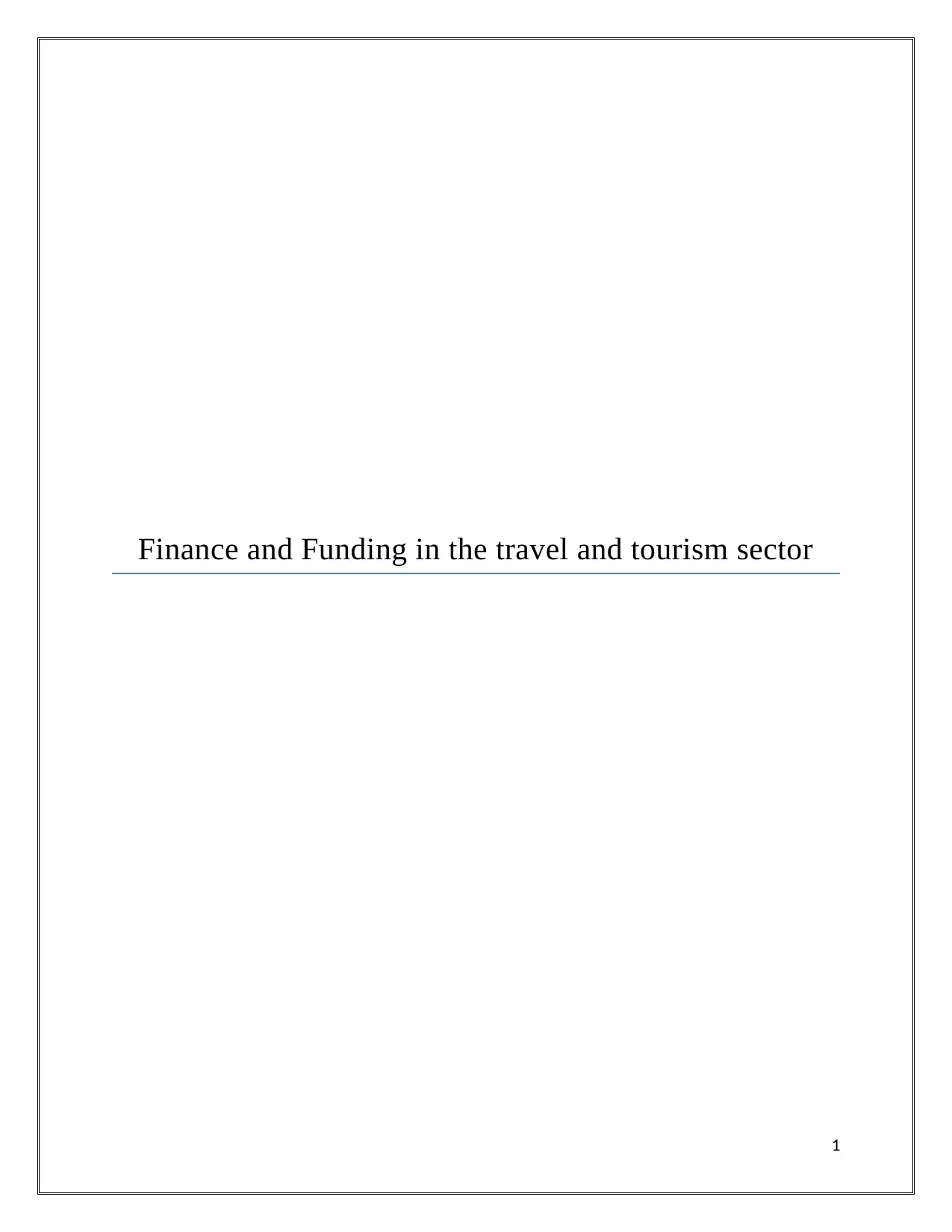
Finance and Funding in the travel and tourism sector
1
1
Secure Best Marks with AI Grader
Need help grading? Try our AI Grader for instant feedback on your assignments.
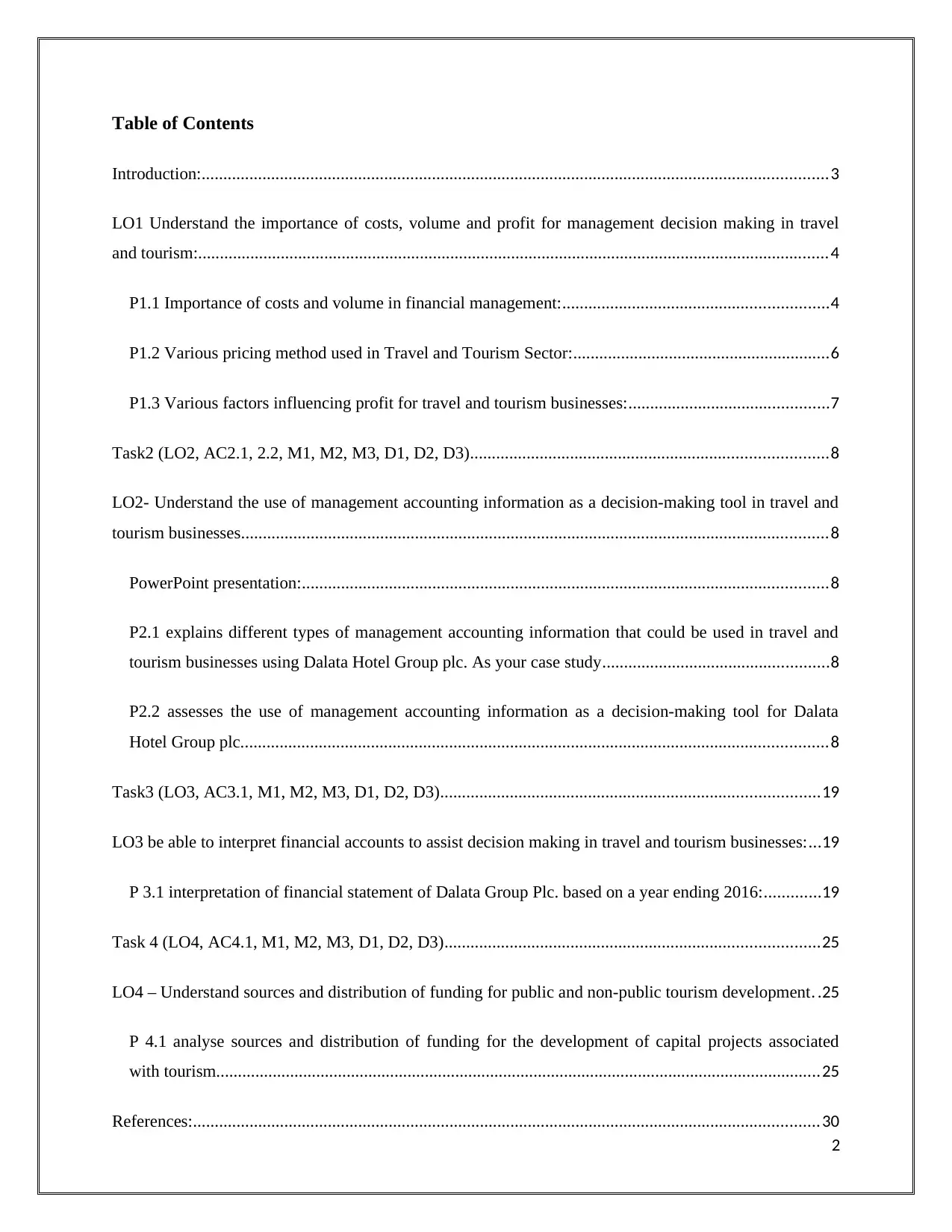
Table of Contents
Introduction:................................................................................................................................................3
LO1 Understand the importance of costs, volume and profit for management decision making in travel
and tourism:.................................................................................................................................................4
P1.1 Importance of costs and volume in financial management:.............................................................4
P1.2 Various pricing method used in Travel and Tourism Sector:...........................................................6
P1.3 Various factors influencing profit for travel and tourism businesses:..............................................7
Task2 (LO2, AC2.1, 2.2, M1, M2, M3, D1, D2, D3)..................................................................................8
LO2- Understand the use of management accounting information as a decision-making tool in travel and
tourism businesses.......................................................................................................................................8
PowerPoint presentation:.........................................................................................................................8
P2.1 explains different types of management accounting information that could be used in travel and
tourism businesses using Dalata Hotel Group plc. As your case study....................................................8
P2.2 assesses the use of management accounting information as a decision-making tool for Dalata
Hotel Group plc.......................................................................................................................................8
Task3 (LO3, AC3.1, M1, M2, M3, D1, D2, D3).......................................................................................19
LO3 be able to interpret financial accounts to assist decision making in travel and tourism businesses:...19
P 3.1 interpretation of financial statement of Dalata Group Plc. based on a year ending 2016:.............19
Task 4 (LO4, AC4.1, M1, M2, M3, D1, D2, D3)......................................................................................25
LO4 – Understand sources and distribution of funding for public and non-public tourism development. .25
P 4.1 analyse sources and distribution of funding for the development of capital projects associated
with tourism...........................................................................................................................................25
References:................................................................................................................................................30
2
Introduction:................................................................................................................................................3
LO1 Understand the importance of costs, volume and profit for management decision making in travel
and tourism:.................................................................................................................................................4
P1.1 Importance of costs and volume in financial management:.............................................................4
P1.2 Various pricing method used in Travel and Tourism Sector:...........................................................6
P1.3 Various factors influencing profit for travel and tourism businesses:..............................................7
Task2 (LO2, AC2.1, 2.2, M1, M2, M3, D1, D2, D3)..................................................................................8
LO2- Understand the use of management accounting information as a decision-making tool in travel and
tourism businesses.......................................................................................................................................8
PowerPoint presentation:.........................................................................................................................8
P2.1 explains different types of management accounting information that could be used in travel and
tourism businesses using Dalata Hotel Group plc. As your case study....................................................8
P2.2 assesses the use of management accounting information as a decision-making tool for Dalata
Hotel Group plc.......................................................................................................................................8
Task3 (LO3, AC3.1, M1, M2, M3, D1, D2, D3).......................................................................................19
LO3 be able to interpret financial accounts to assist decision making in travel and tourism businesses:...19
P 3.1 interpretation of financial statement of Dalata Group Plc. based on a year ending 2016:.............19
Task 4 (LO4, AC4.1, M1, M2, M3, D1, D2, D3)......................................................................................25
LO4 – Understand sources and distribution of funding for public and non-public tourism development. .25
P 4.1 analyse sources and distribution of funding for the development of capital projects associated
with tourism...........................................................................................................................................25
References:................................................................................................................................................30
2
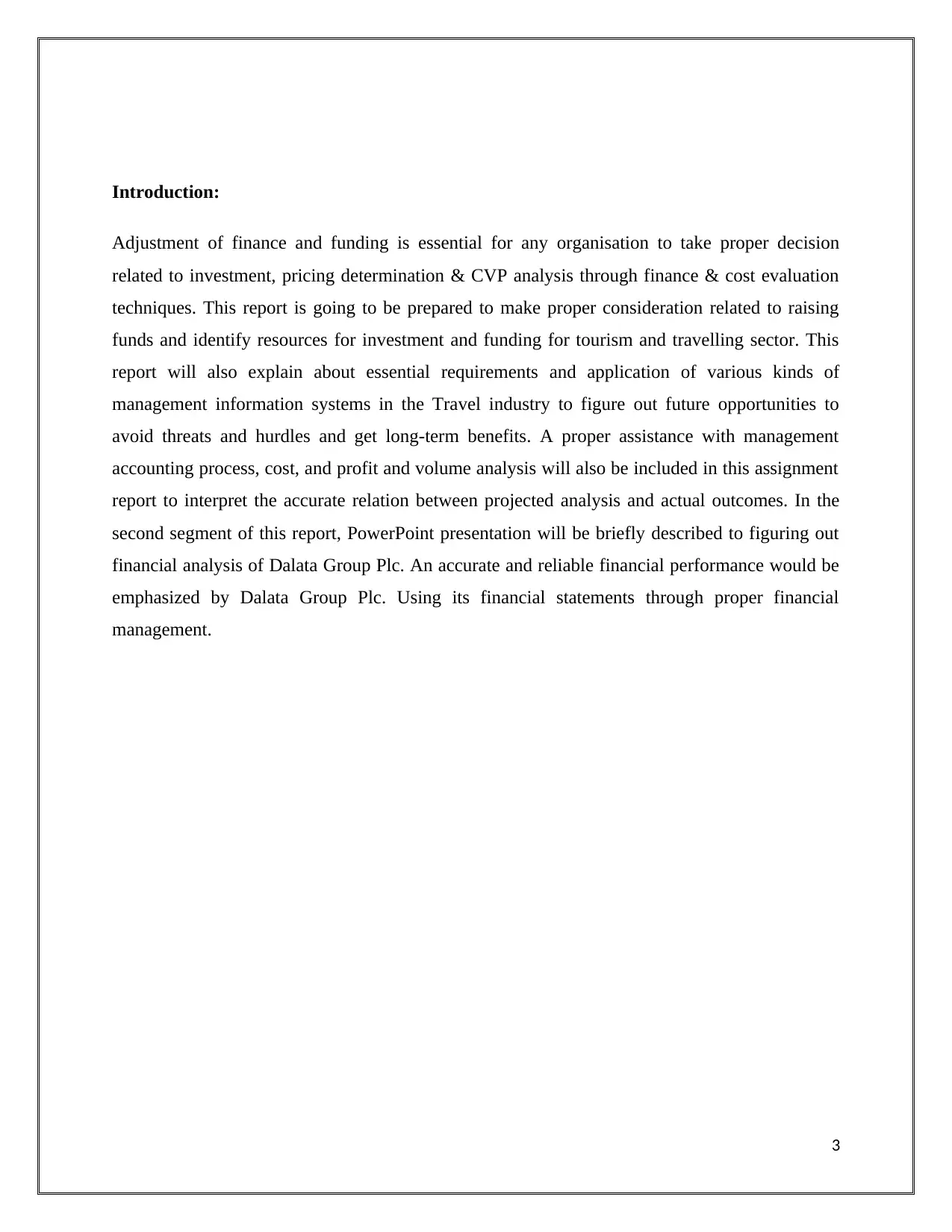
Introduction:
Adjustment of finance and funding is essential for any organisation to take proper decision
related to investment, pricing determination & CVP analysis through finance & cost evaluation
techniques. This report is going to be prepared to make proper consideration related to raising
funds and identify resources for investment and funding for tourism and travelling sector. This
report will also explain about essential requirements and application of various kinds of
management information systems in the Travel industry to figure out future opportunities to
avoid threats and hurdles and get long-term benefits. A proper assistance with management
accounting process, cost, and profit and volume analysis will also be included in this assignment
report to interpret the accurate relation between projected analysis and actual outcomes. In the
second segment of this report, PowerPoint presentation will be briefly described to figuring out
financial analysis of Dalata Group Plc. An accurate and reliable financial performance would be
emphasized by Dalata Group Plc. Using its financial statements through proper financial
management.
3
Adjustment of finance and funding is essential for any organisation to take proper decision
related to investment, pricing determination & CVP analysis through finance & cost evaluation
techniques. This report is going to be prepared to make proper consideration related to raising
funds and identify resources for investment and funding for tourism and travelling sector. This
report will also explain about essential requirements and application of various kinds of
management information systems in the Travel industry to figure out future opportunities to
avoid threats and hurdles and get long-term benefits. A proper assistance with management
accounting process, cost, and profit and volume analysis will also be included in this assignment
report to interpret the accurate relation between projected analysis and actual outcomes. In the
second segment of this report, PowerPoint presentation will be briefly described to figuring out
financial analysis of Dalata Group Plc. An accurate and reliable financial performance would be
emphasized by Dalata Group Plc. Using its financial statements through proper financial
management.
3
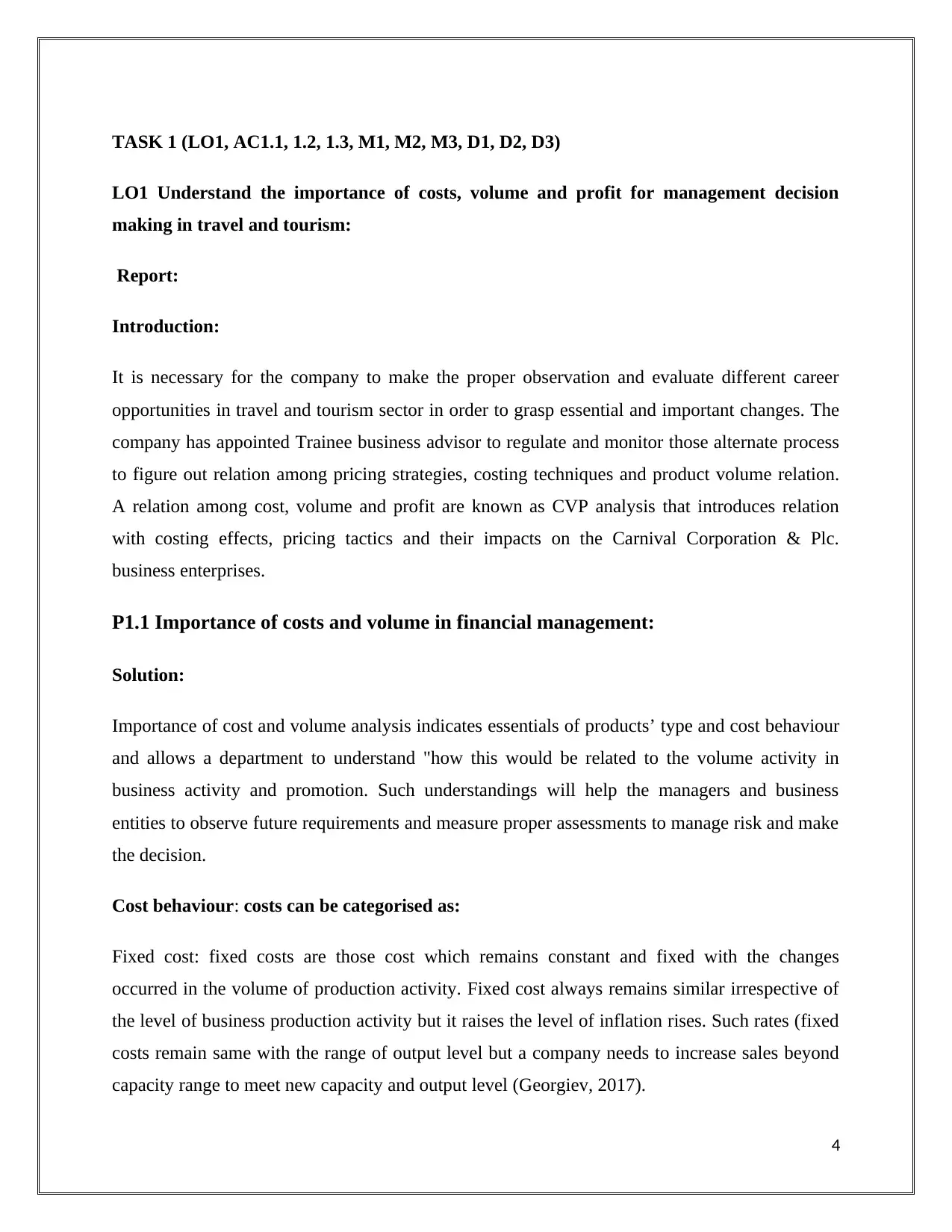
TASK 1 (LO1, AC1.1, 1.2, 1.3, M1, M2, M3, D1, D2, D3)
LO1 Understand the importance of costs, volume and profit for management decision
making in travel and tourism:
Report:
Introduction:
It is necessary for the company to make the proper observation and evaluate different career
opportunities in travel and tourism sector in order to grasp essential and important changes. The
company has appointed Trainee business advisor to regulate and monitor those alternate process
to figure out relation among pricing strategies, costing techniques and product volume relation.
A relation among cost, volume and profit are known as CVP analysis that introduces relation
with costing effects, pricing tactics and their impacts on the Carnival Corporation & Plc.
business enterprises.
P1.1 Importance of costs and volume in financial management:
Solution:
Importance of cost and volume analysis indicates essentials of products’ type and cost behaviour
and allows a department to understand "how this would be related to the volume activity in
business activity and promotion. Such understandings will help the managers and business
entities to observe future requirements and measure proper assessments to manage risk and make
the decision.
Cost behaviour: costs can be categorised as:
Fixed cost: fixed costs are those cost which remains constant and fixed with the changes
occurred in the volume of production activity. Fixed cost always remains similar irrespective of
the level of business production activity but it raises the level of inflation rises. Such rates (fixed
costs remain same with the range of output level but a company needs to increase sales beyond
capacity range to meet new capacity and output level (Georgiev, 2017).
4
LO1 Understand the importance of costs, volume and profit for management decision
making in travel and tourism:
Report:
Introduction:
It is necessary for the company to make the proper observation and evaluate different career
opportunities in travel and tourism sector in order to grasp essential and important changes. The
company has appointed Trainee business advisor to regulate and monitor those alternate process
to figure out relation among pricing strategies, costing techniques and product volume relation.
A relation among cost, volume and profit are known as CVP analysis that introduces relation
with costing effects, pricing tactics and their impacts on the Carnival Corporation & Plc.
business enterprises.
P1.1 Importance of costs and volume in financial management:
Solution:
Importance of cost and volume analysis indicates essentials of products’ type and cost behaviour
and allows a department to understand "how this would be related to the volume activity in
business activity and promotion. Such understandings will help the managers and business
entities to observe future requirements and measure proper assessments to manage risk and make
the decision.
Cost behaviour: costs can be categorised as:
Fixed cost: fixed costs are those cost which remains constant and fixed with the changes
occurred in the volume of production activity. Fixed cost always remains similar irrespective of
the level of business production activity but it raises the level of inflation rises. Such rates (fixed
costs remain same with the range of output level but a company needs to increase sales beyond
capacity range to meet new capacity and output level (Georgiev, 2017).
4
Secure Best Marks with AI Grader
Need help grading? Try our AI Grader for instant feedback on your assignments.
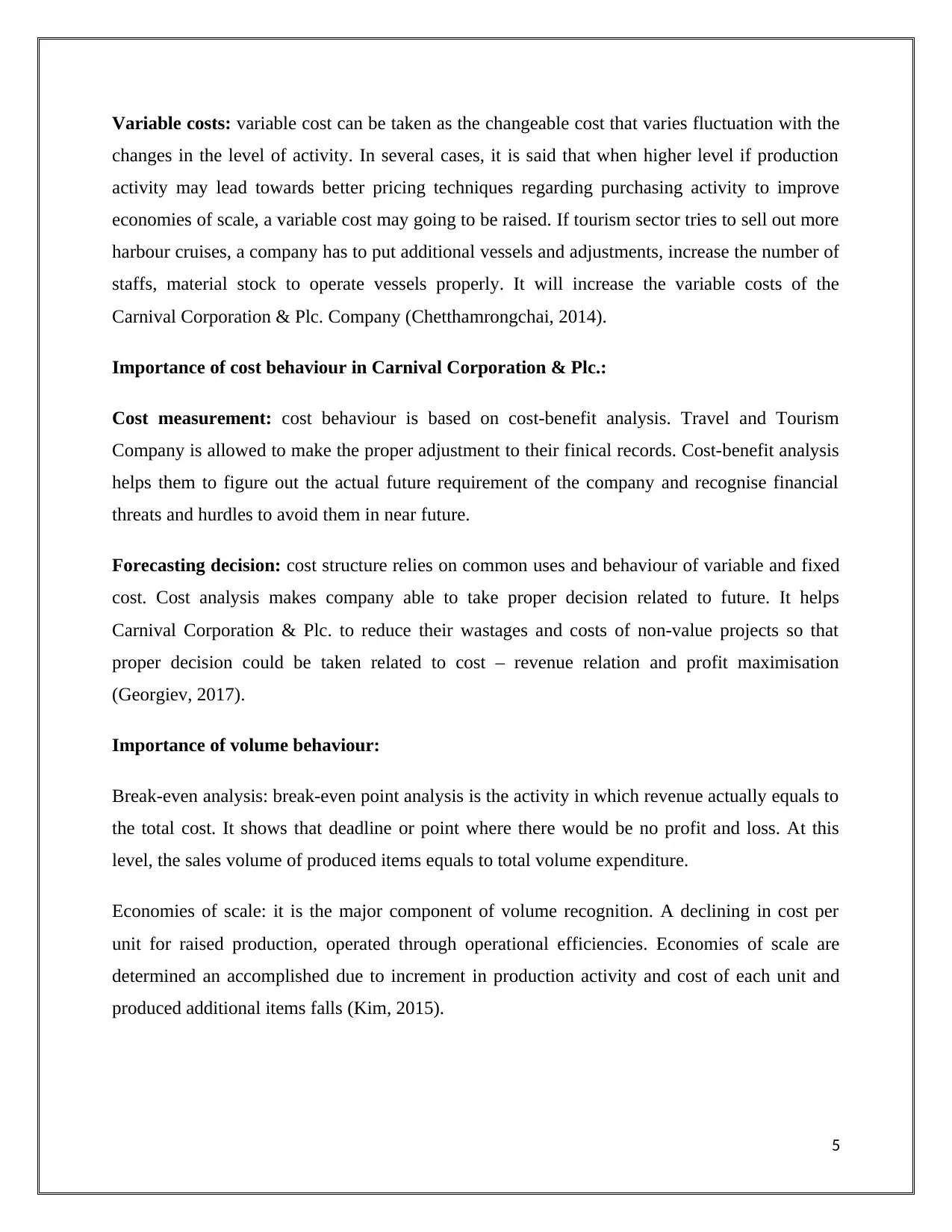
Variable costs: variable cost can be taken as the changeable cost that varies fluctuation with the
changes in the level of activity. In several cases, it is said that when higher level if production
activity may lead towards better pricing techniques regarding purchasing activity to improve
economies of scale, a variable cost may going to be raised. If tourism sector tries to sell out more
harbour cruises, a company has to put additional vessels and adjustments, increase the number of
staffs, material stock to operate vessels properly. It will increase the variable costs of the
Carnival Corporation & Plc. Company (Chetthamrongchai, 2014).
Importance of cost behaviour in Carnival Corporation & Plc.:
Cost measurement: cost behaviour is based on cost-benefit analysis. Travel and Tourism
Company is allowed to make the proper adjustment to their finical records. Cost-benefit analysis
helps them to figure out the actual future requirement of the company and recognise financial
threats and hurdles to avoid them in near future.
Forecasting decision: cost structure relies on common uses and behaviour of variable and fixed
cost. Cost analysis makes company able to take proper decision related to future. It helps
Carnival Corporation & Plc. to reduce their wastages and costs of non-value projects so that
proper decision could be taken related to cost – revenue relation and profit maximisation
(Georgiev, 2017).
Importance of volume behaviour:
Break-even analysis: break-even point analysis is the activity in which revenue actually equals to
the total cost. It shows that deadline or point where there would be no profit and loss. At this
level, the sales volume of produced items equals to total volume expenditure.
Economies of scale: it is the major component of volume recognition. A declining in cost per
unit for raised production, operated through operational efficiencies. Economies of scale are
determined an accomplished due to increment in production activity and cost of each unit and
produced additional items falls (Kim, 2015).
5
changes in the level of activity. In several cases, it is said that when higher level if production
activity may lead towards better pricing techniques regarding purchasing activity to improve
economies of scale, a variable cost may going to be raised. If tourism sector tries to sell out more
harbour cruises, a company has to put additional vessels and adjustments, increase the number of
staffs, material stock to operate vessels properly. It will increase the variable costs of the
Carnival Corporation & Plc. Company (Chetthamrongchai, 2014).
Importance of cost behaviour in Carnival Corporation & Plc.:
Cost measurement: cost behaviour is based on cost-benefit analysis. Travel and Tourism
Company is allowed to make the proper adjustment to their finical records. Cost-benefit analysis
helps them to figure out the actual future requirement of the company and recognise financial
threats and hurdles to avoid them in near future.
Forecasting decision: cost structure relies on common uses and behaviour of variable and fixed
cost. Cost analysis makes company able to take proper decision related to future. It helps
Carnival Corporation & Plc. to reduce their wastages and costs of non-value projects so that
proper decision could be taken related to cost – revenue relation and profit maximisation
(Georgiev, 2017).
Importance of volume behaviour:
Break-even analysis: break-even point analysis is the activity in which revenue actually equals to
the total cost. It shows that deadline or point where there would be no profit and loss. At this
level, the sales volume of produced items equals to total volume expenditure.
Economies of scale: it is the major component of volume recognition. A declining in cost per
unit for raised production, operated through operational efficiencies. Economies of scale are
determined an accomplished due to increment in production activity and cost of each unit and
produced additional items falls (Kim, 2015).
5
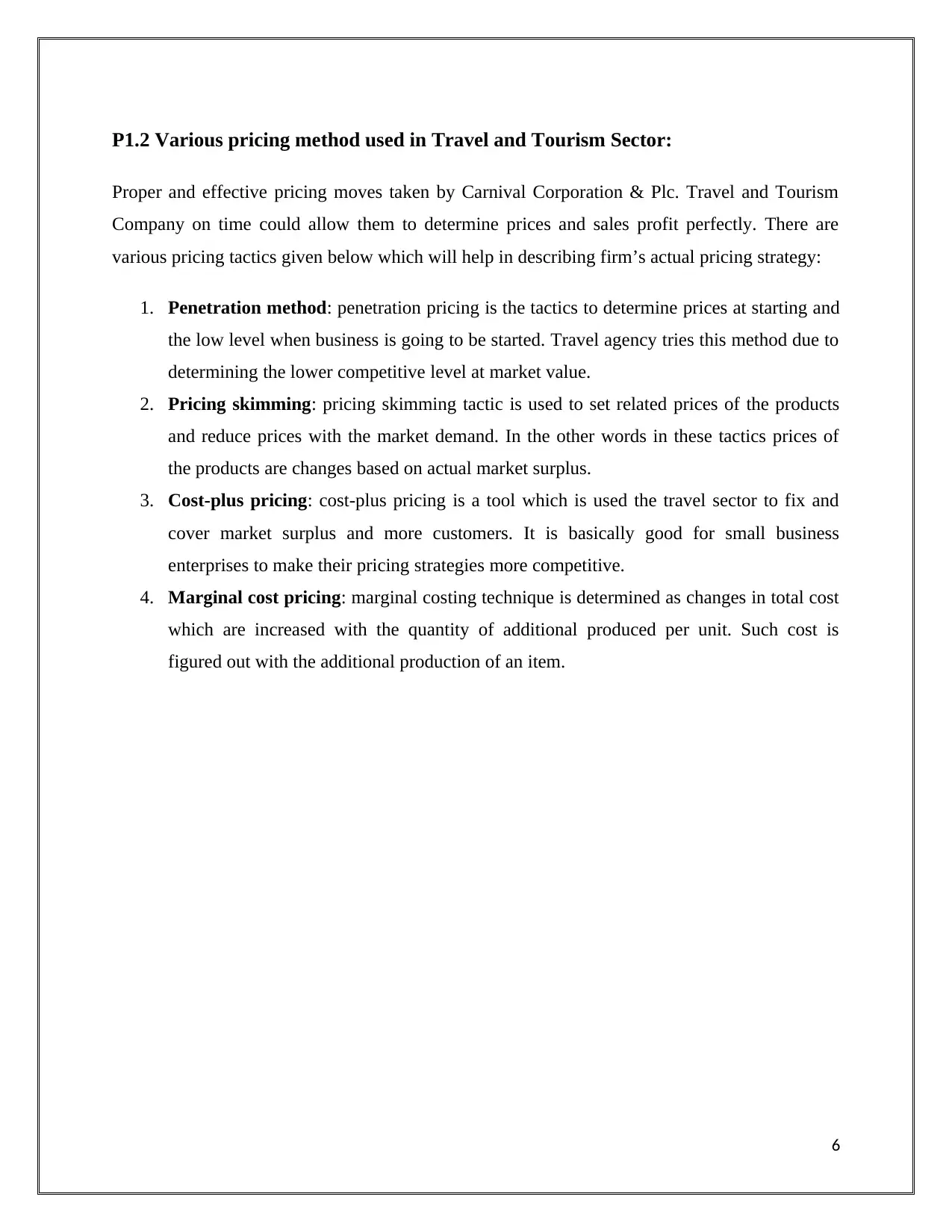
P1.2 Various pricing method used in Travel and Tourism Sector:
Proper and effective pricing moves taken by Carnival Corporation & Plc. Travel and Tourism
Company on time could allow them to determine prices and sales profit perfectly. There are
various pricing tactics given below which will help in describing firm’s actual pricing strategy:
1. Penetration method: penetration pricing is the tactics to determine prices at starting and
the low level when business is going to be started. Travel agency tries this method due to
determining the lower competitive level at market value.
2. Pricing skimming: pricing skimming tactic is used to set related prices of the products
and reduce prices with the market demand. In the other words in these tactics prices of
the products are changes based on actual market surplus.
3. Cost-plus pricing: cost-plus pricing is a tool which is used the travel sector to fix and
cover market surplus and more customers. It is basically good for small business
enterprises to make their pricing strategies more competitive.
4. Marginal cost pricing: marginal costing technique is determined as changes in total cost
which are increased with the quantity of additional produced per unit. Such cost is
figured out with the additional production of an item.
6
Proper and effective pricing moves taken by Carnival Corporation & Plc. Travel and Tourism
Company on time could allow them to determine prices and sales profit perfectly. There are
various pricing tactics given below which will help in describing firm’s actual pricing strategy:
1. Penetration method: penetration pricing is the tactics to determine prices at starting and
the low level when business is going to be started. Travel agency tries this method due to
determining the lower competitive level at market value.
2. Pricing skimming: pricing skimming tactic is used to set related prices of the products
and reduce prices with the market demand. In the other words in these tactics prices of
the products are changes based on actual market surplus.
3. Cost-plus pricing: cost-plus pricing is a tool which is used the travel sector to fix and
cover market surplus and more customers. It is basically good for small business
enterprises to make their pricing strategies more competitive.
4. Marginal cost pricing: marginal costing technique is determined as changes in total cost
which are increased with the quantity of additional produced per unit. Such cost is
figured out with the additional production of an item.
6
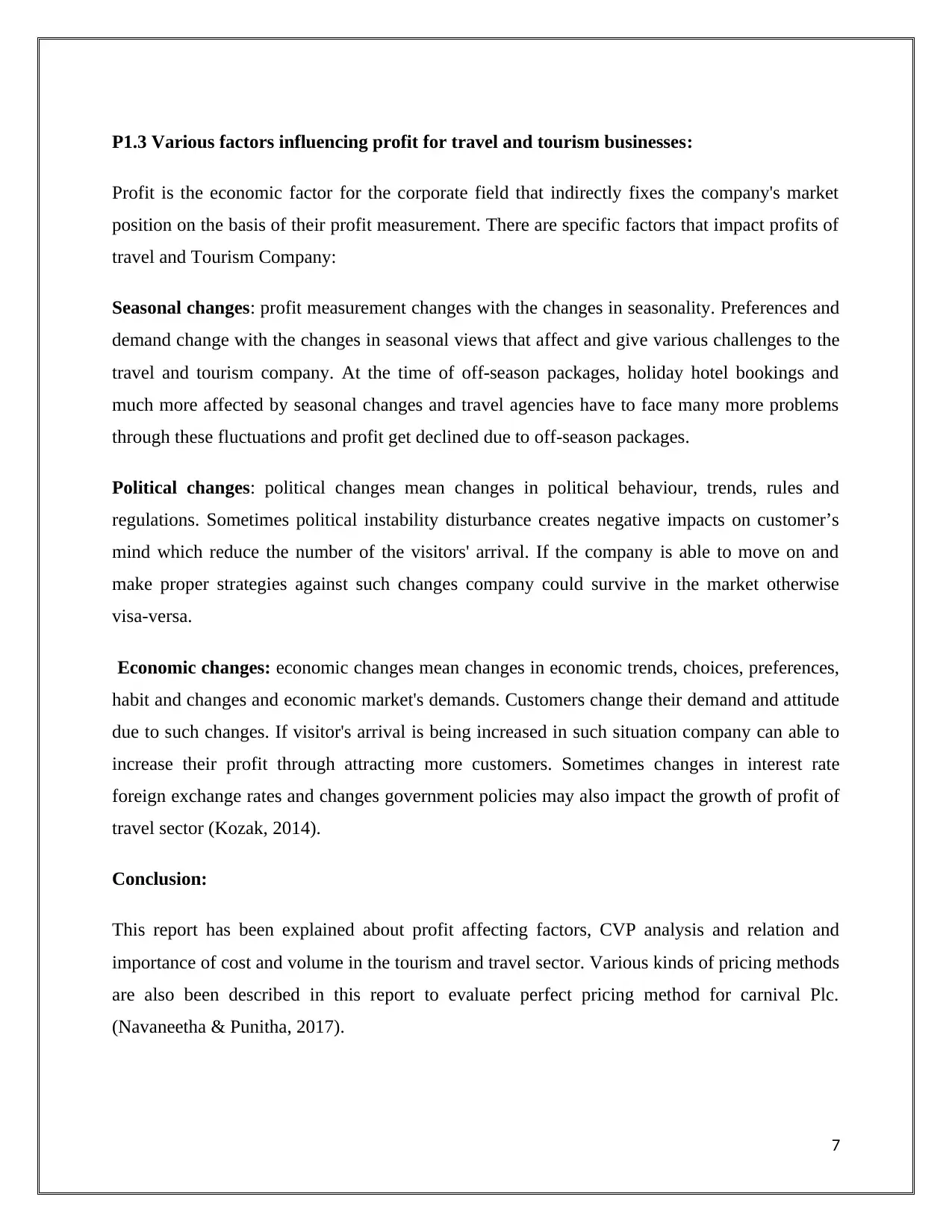
P1.3 Various factors influencing profit for travel and tourism businesses:
Profit is the economic factor for the corporate field that indirectly fixes the company's market
position on the basis of their profit measurement. There are specific factors that impact profits of
travel and Tourism Company:
Seasonal changes: profit measurement changes with the changes in seasonality. Preferences and
demand change with the changes in seasonal views that affect and give various challenges to the
travel and tourism company. At the time of off-season packages, holiday hotel bookings and
much more affected by seasonal changes and travel agencies have to face many more problems
through these fluctuations and profit get declined due to off-season packages.
Political changes: political changes mean changes in political behaviour, trends, rules and
regulations. Sometimes political instability disturbance creates negative impacts on customer’s
mind which reduce the number of the visitors' arrival. If the company is able to move on and
make proper strategies against such changes company could survive in the market otherwise
visa-versa.
Economic changes: economic changes mean changes in economic trends, choices, preferences,
habit and changes and economic market's demands. Customers change their demand and attitude
due to such changes. If visitor's arrival is being increased in such situation company can able to
increase their profit through attracting more customers. Sometimes changes in interest rate
foreign exchange rates and changes government policies may also impact the growth of profit of
travel sector (Kozak, 2014).
Conclusion:
This report has been explained about profit affecting factors, CVP analysis and relation and
importance of cost and volume in the tourism and travel sector. Various kinds of pricing methods
are also been described in this report to evaluate perfect pricing method for carnival Plc.
(Navaneetha & Punitha, 2017).
7
Profit is the economic factor for the corporate field that indirectly fixes the company's market
position on the basis of their profit measurement. There are specific factors that impact profits of
travel and Tourism Company:
Seasonal changes: profit measurement changes with the changes in seasonality. Preferences and
demand change with the changes in seasonal views that affect and give various challenges to the
travel and tourism company. At the time of off-season packages, holiday hotel bookings and
much more affected by seasonal changes and travel agencies have to face many more problems
through these fluctuations and profit get declined due to off-season packages.
Political changes: political changes mean changes in political behaviour, trends, rules and
regulations. Sometimes political instability disturbance creates negative impacts on customer’s
mind which reduce the number of the visitors' arrival. If the company is able to move on and
make proper strategies against such changes company could survive in the market otherwise
visa-versa.
Economic changes: economic changes mean changes in economic trends, choices, preferences,
habit and changes and economic market's demands. Customers change their demand and attitude
due to such changes. If visitor's arrival is being increased in such situation company can able to
increase their profit through attracting more customers. Sometimes changes in interest rate
foreign exchange rates and changes government policies may also impact the growth of profit of
travel sector (Kozak, 2014).
Conclusion:
This report has been explained about profit affecting factors, CVP analysis and relation and
importance of cost and volume in the tourism and travel sector. Various kinds of pricing methods
are also been described in this report to evaluate perfect pricing method for carnival Plc.
(Navaneetha & Punitha, 2017).
7
Paraphrase This Document
Need a fresh take? Get an instant paraphrase of this document with our AI Paraphraser
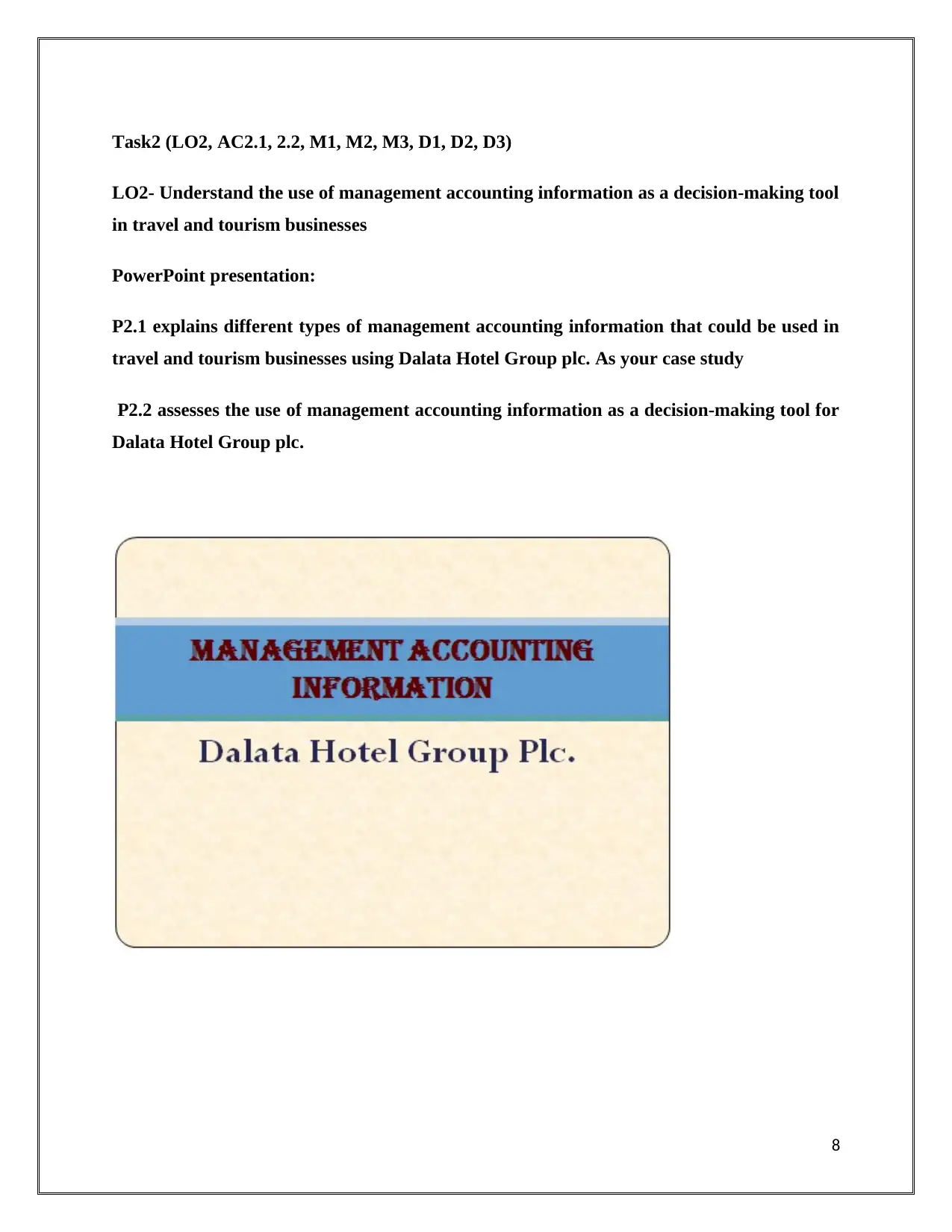
Task2 (LO2, AC2.1, 2.2, M1, M2, M3, D1, D2, D3)
LO2- Understand the use of management accounting information as a decision-making tool
in travel and tourism businesses
PowerPoint presentation:
P2.1 explains different types of management accounting information that could be used in
travel and tourism businesses using Dalata Hotel Group plc. As your case study
P2.2 assesses the use of management accounting information as a decision-making tool for
Dalata Hotel Group plc.
8
LO2- Understand the use of management accounting information as a decision-making tool
in travel and tourism businesses
PowerPoint presentation:
P2.1 explains different types of management accounting information that could be used in
travel and tourism businesses using Dalata Hotel Group plc. As your case study
P2.2 assesses the use of management accounting information as a decision-making tool for
Dalata Hotel Group plc.
8
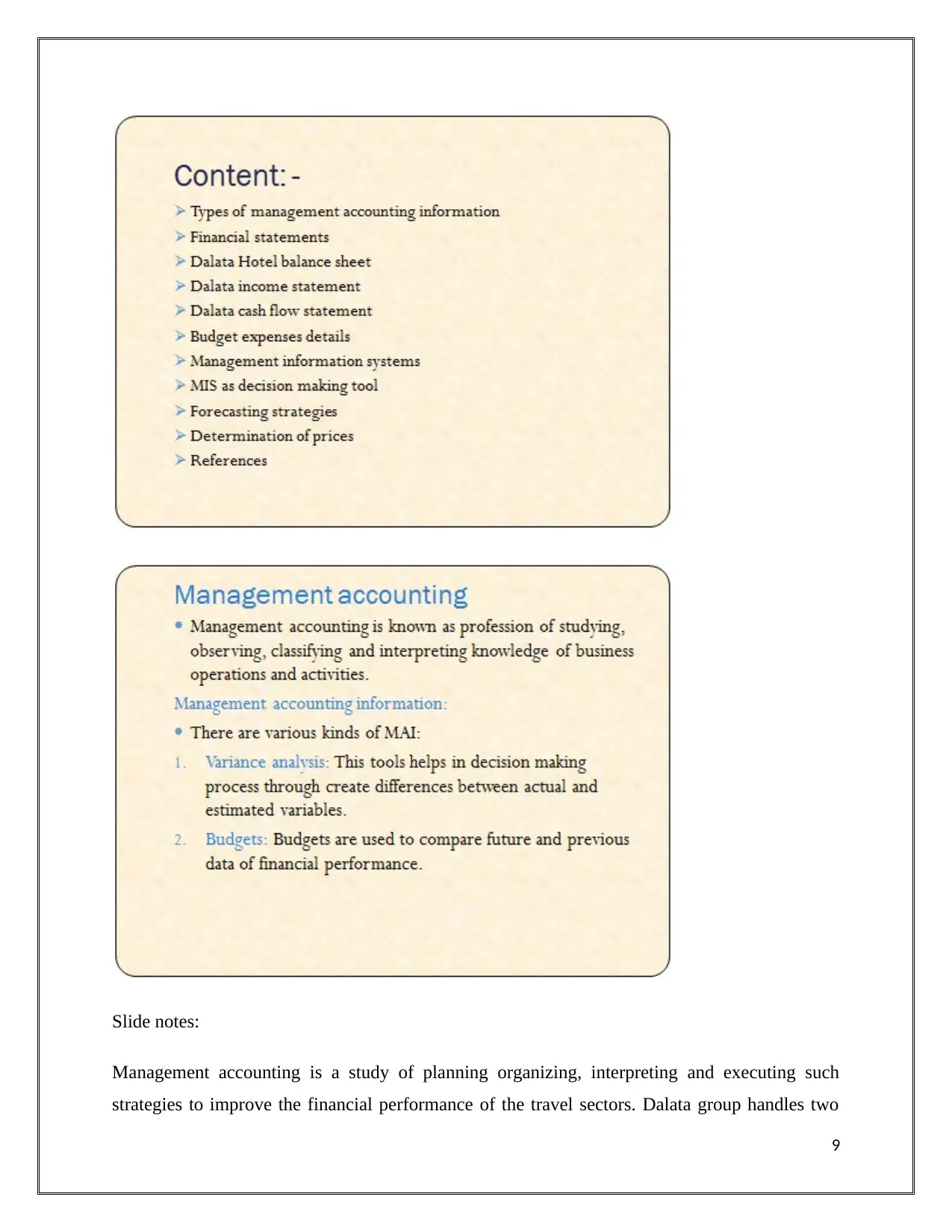
Slide notes:
Management accounting is a study of planning organizing, interpreting and executing such
strategies to improve the financial performance of the travel sectors. Dalata group handles two
9
Management accounting is a study of planning organizing, interpreting and executing such
strategies to improve the financial performance of the travel sectors. Dalata group handles two
9
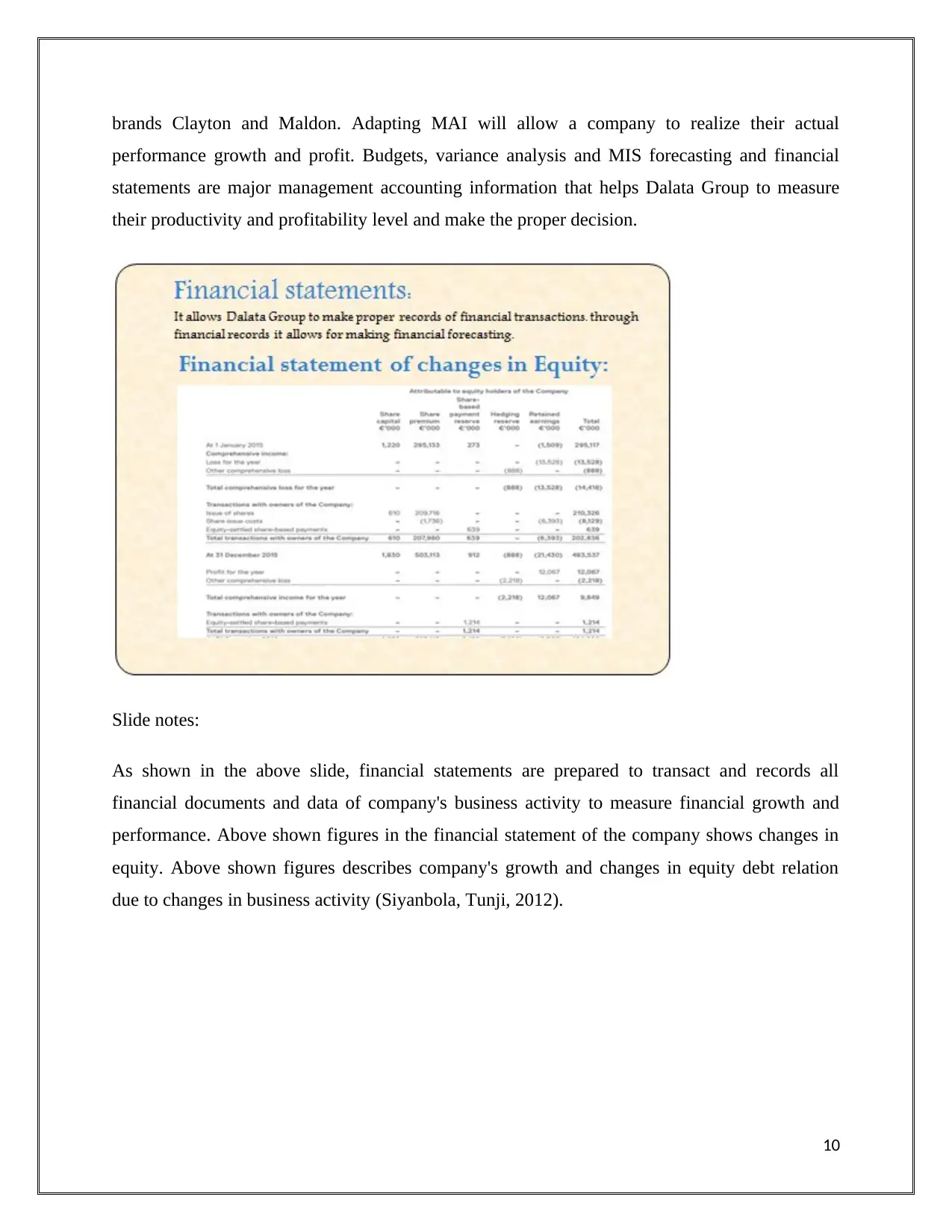
brands Clayton and Maldon. Adapting MAI will allow a company to realize their actual
performance growth and profit. Budgets, variance analysis and MIS forecasting and financial
statements are major management accounting information that helps Dalata Group to measure
their productivity and profitability level and make the proper decision.
Slide notes:
As shown in the above slide, financial statements are prepared to transact and records all
financial documents and data of company's business activity to measure financial growth and
performance. Above shown figures in the financial statement of the company shows changes in
equity. Above shown figures describes company's growth and changes in equity debt relation
due to changes in business activity (Siyanbola, Tunji, 2012).
10
performance growth and profit. Budgets, variance analysis and MIS forecasting and financial
statements are major management accounting information that helps Dalata Group to measure
their productivity and profitability level and make the proper decision.
Slide notes:
As shown in the above slide, financial statements are prepared to transact and records all
financial documents and data of company's business activity to measure financial growth and
performance. Above shown figures in the financial statement of the company shows changes in
equity. Above shown figures describes company's growth and changes in equity debt relation
due to changes in business activity (Siyanbola, Tunji, 2012).
10
Secure Best Marks with AI Grader
Need help grading? Try our AI Grader for instant feedback on your assignments.

Slide notes:
In the context of above data given in Dalata hotel balance sheet describes accounting information
related to changes in assets and liabilities formation from 2015 to 2016. In 2016 total recorded
assets was 785,920 and in 2016 it was 754,044 which shows dissolution of assets. Total recorded
liabilities were 785,920 with total equity relation 494,600 in FY16.
11
In the context of above data given in Dalata hotel balance sheet describes accounting information
related to changes in assets and liabilities formation from 2015 to 2016. In 2016 total recorded
assets was 785,920 and in 2016 it was 754,044 which shows dissolution of assets. Total recorded
liabilities were 785,920 with total equity relation 494,600 in FY16.
11

Slide notes:
In the context of above data given in Dalata hotel cash flow statement this management
information includes detailing of funds flow and cash flow generated from operation for Dalata
group Plc. In the year of 2015, cash flow from operating activities was 12,067 and in 2015 it was
15,526 that were recorded as loss. Total cash and cash equivalent was 43,388 which was lower
than 2015 128,499.
12
In the context of above data given in Dalata hotel cash flow statement this management
information includes detailing of funds flow and cash flow generated from operation for Dalata
group Plc. In the year of 2015, cash flow from operating activities was 12,067 and in 2015 it was
15,526 that were recorded as loss. Total cash and cash equivalent was 43,388 which was lower
than 2015 128,499.
12

Slide notes:
Budget expenses are used to create and handle budgeted figures of company's performance. It
helps the Dalata group to itemize expected income and expenses. Dalata Company prepares
budgeted expenses to ensure management of production, sales and purchasing activities.
13
Budget expenses are used to create and handle budgeted figures of company's performance. It
helps the Dalata group to itemize expected income and expenses. Dalata Company prepares
budgeted expenses to ensure management of production, sales and purchasing activities.
13
Paraphrase This Document
Need a fresh take? Get an instant paraphrase of this document with our AI Paraphraser
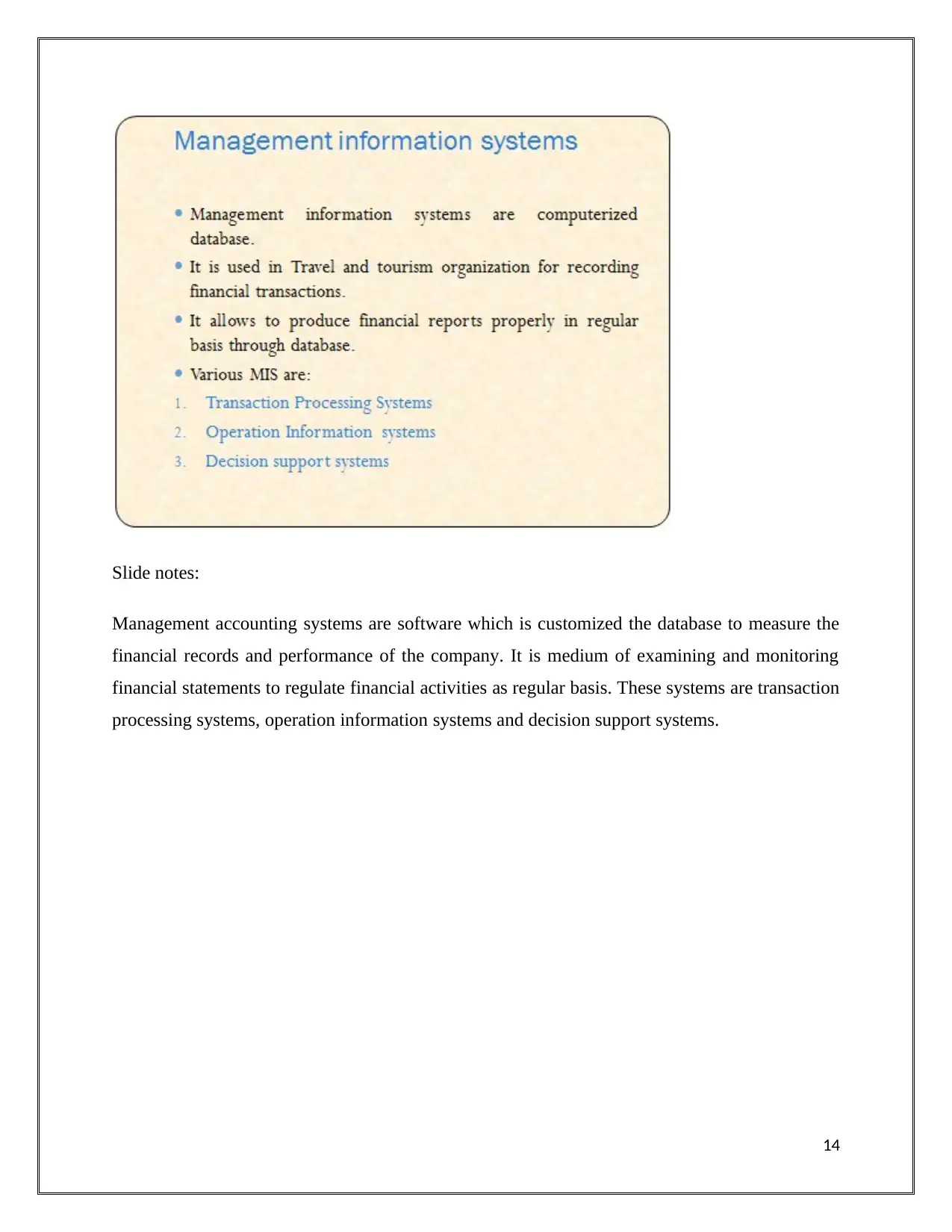
Slide notes:
Management accounting systems are software which is customized the database to measure the
financial records and performance of the company. It is medium of examining and monitoring
financial statements to regulate financial activities as regular basis. These systems are transaction
processing systems, operation information systems and decision support systems.
14
Management accounting systems are software which is customized the database to measure the
financial records and performance of the company. It is medium of examining and monitoring
financial statements to regulate financial activities as regular basis. These systems are transaction
processing systems, operation information systems and decision support systems.
14
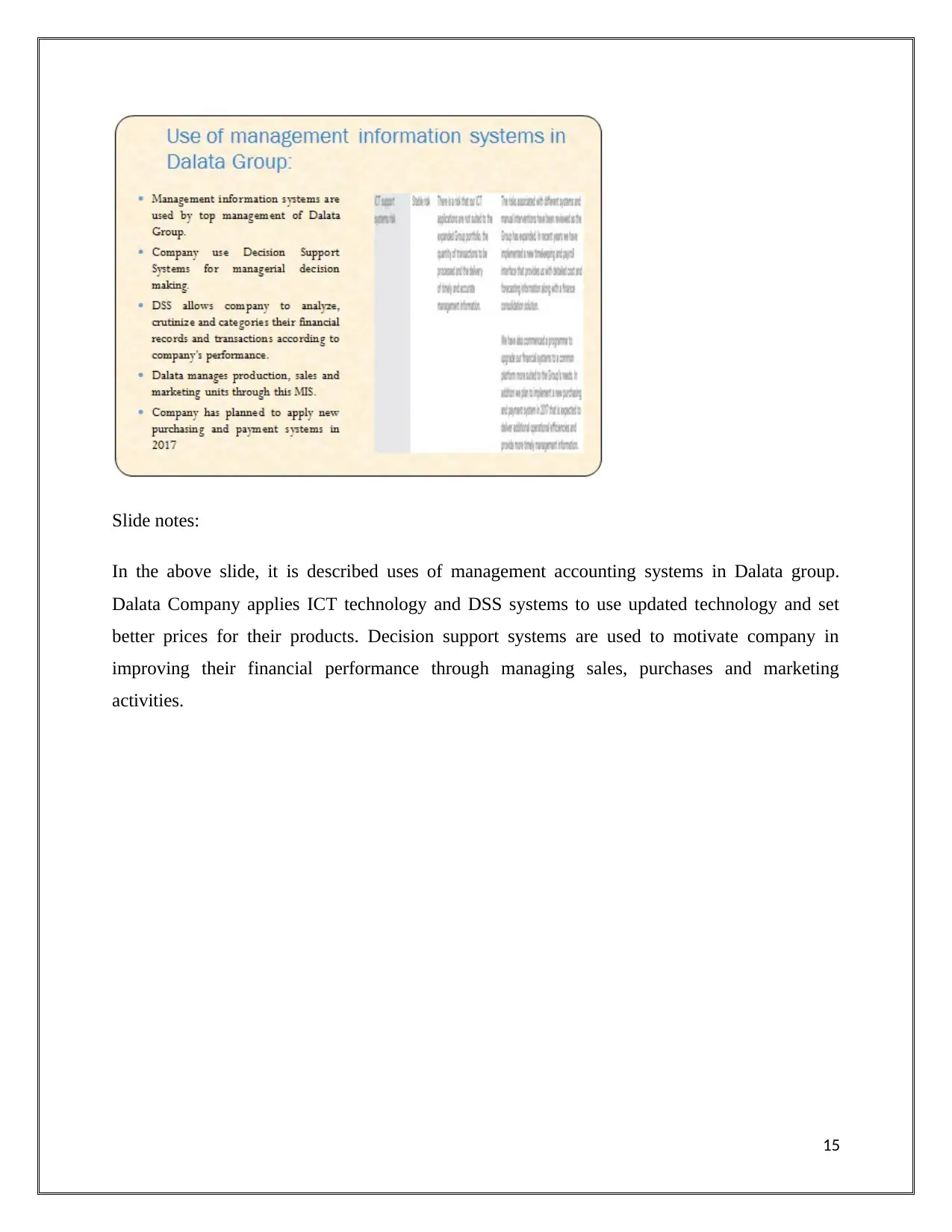
Slide notes:
In the above slide, it is described uses of management accounting systems in Dalata group.
Dalata Company applies ICT technology and DSS systems to use updated technology and set
better prices for their products. Decision support systems are used to motivate company in
improving their financial performance through managing sales, purchases and marketing
activities.
15
In the above slide, it is described uses of management accounting systems in Dalata group.
Dalata Company applies ICT technology and DSS systems to use updated technology and set
better prices for their products. Decision support systems are used to motivate company in
improving their financial performance through managing sales, purchases and marketing
activities.
15
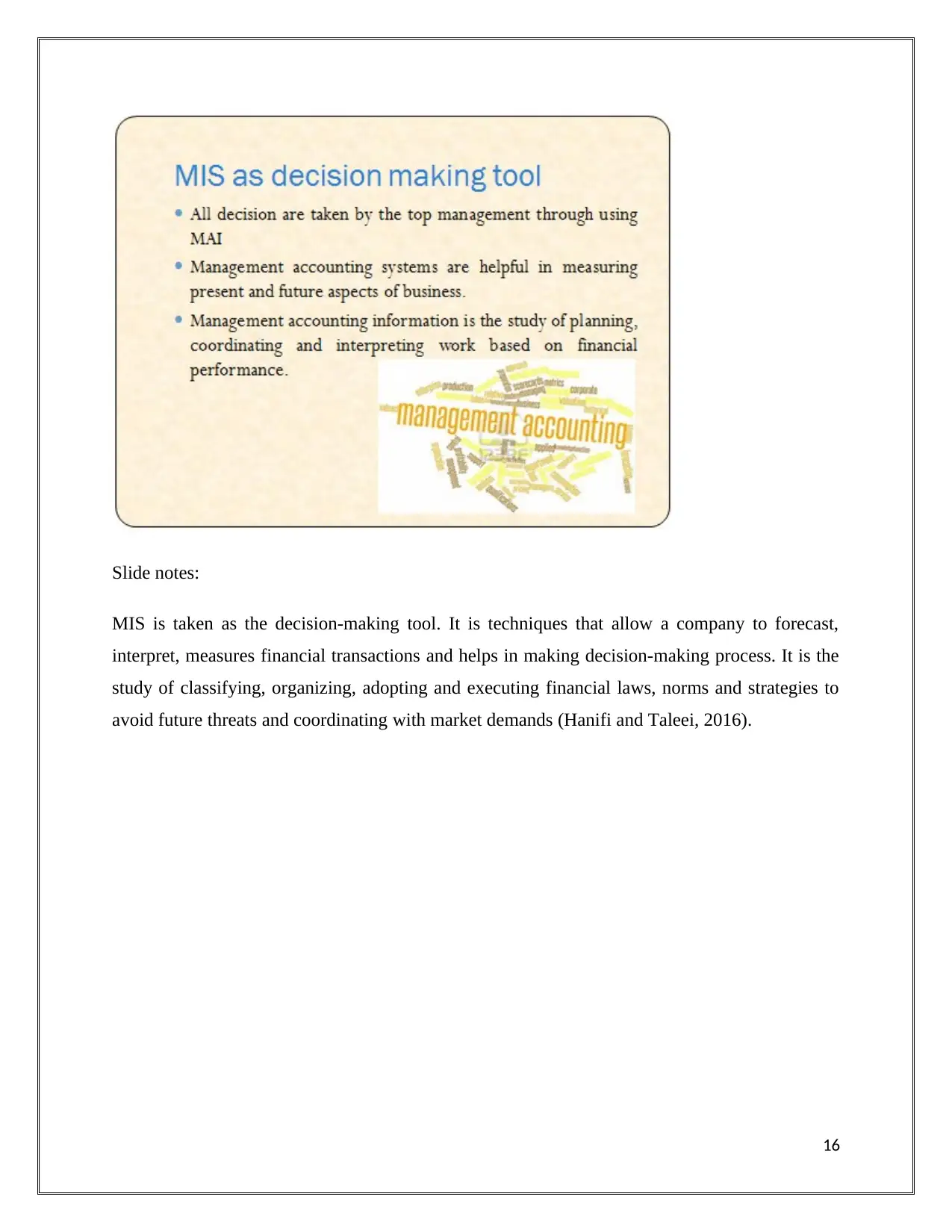
Slide notes:
MIS is taken as the decision-making tool. It is techniques that allow a company to forecast,
interpret, measures financial transactions and helps in making decision-making process. It is the
study of classifying, organizing, adopting and executing financial laws, norms and strategies to
avoid future threats and coordinating with market demands (Hanifi and Taleei, 2016).
16
MIS is taken as the decision-making tool. It is techniques that allow a company to forecast,
interpret, measures financial transactions and helps in making decision-making process. It is the
study of classifying, organizing, adopting and executing financial laws, norms and strategies to
avoid future threats and coordinating with market demands (Hanifi and Taleei, 2016).
16
Secure Best Marks with AI Grader
Need help grading? Try our AI Grader for instant feedback on your assignments.
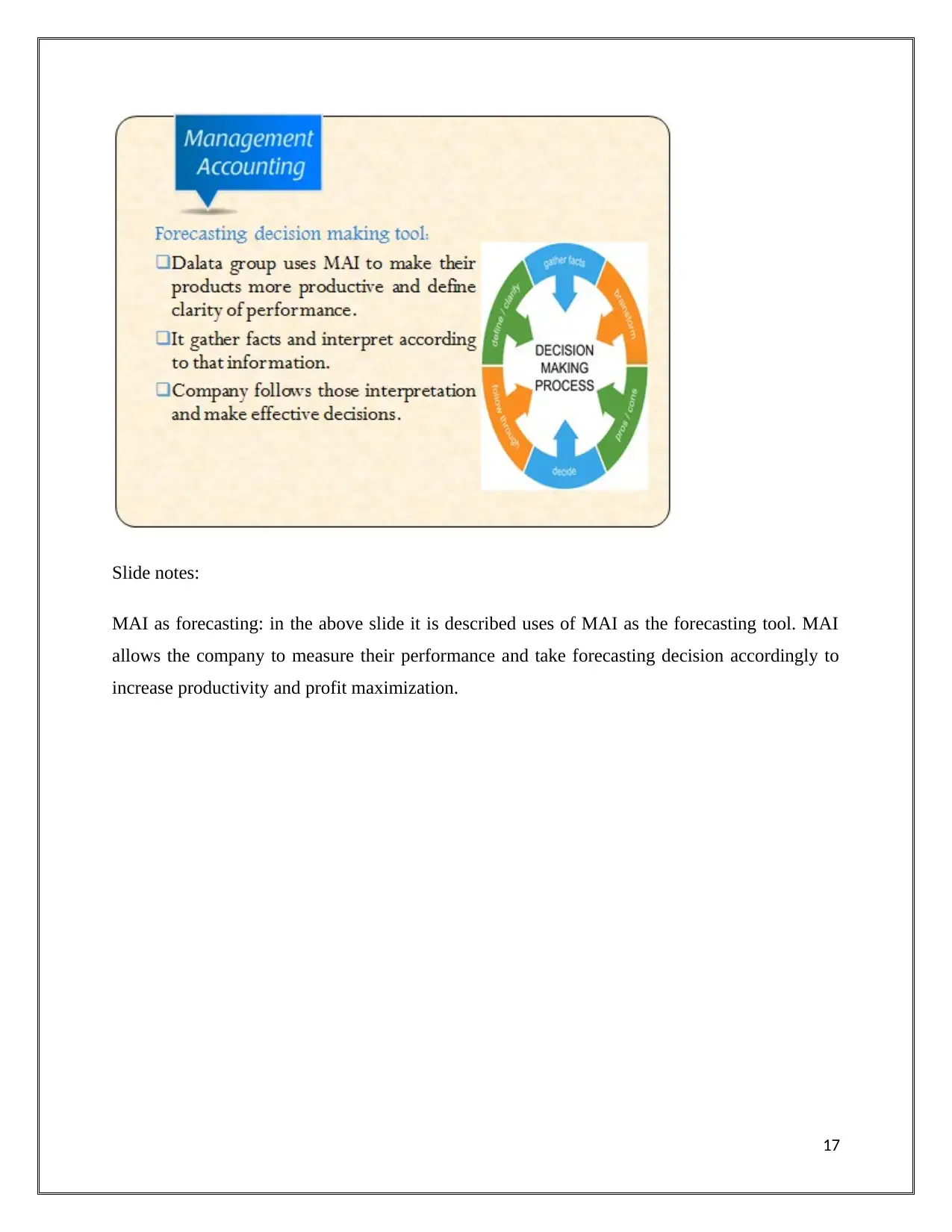
Slide notes:
MAI as forecasting: in the above slide it is described uses of MAI as the forecasting tool. MAI
allows the company to measure their performance and take forecasting decision accordingly to
increase productivity and profit maximization.
17
MAI as forecasting: in the above slide it is described uses of MAI as the forecasting tool. MAI
allows the company to measure their performance and take forecasting decision accordingly to
increase productivity and profit maximization.
17
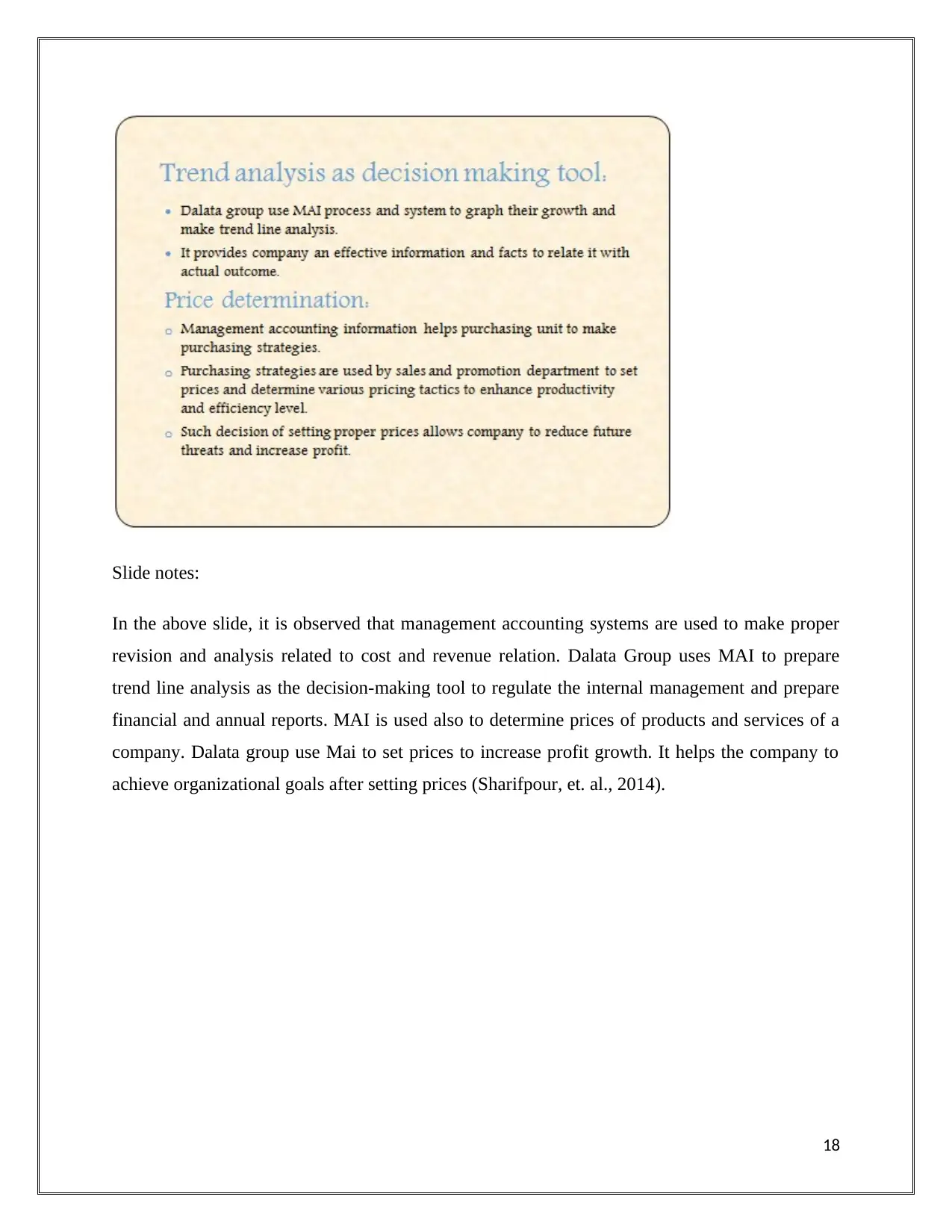
Slide notes:
In the above slide, it is observed that management accounting systems are used to make proper
revision and analysis related to cost and revenue relation. Dalata Group uses MAI to prepare
trend line analysis as the decision-making tool to regulate the internal management and prepare
financial and annual reports. MAI is used also to determine prices of products and services of a
company. Dalata group use Mai to set prices to increase profit growth. It helps the company to
achieve organizational goals after setting prices (Sharifpour, et. al., 2014).
18
In the above slide, it is observed that management accounting systems are used to make proper
revision and analysis related to cost and revenue relation. Dalata Group uses MAI to prepare
trend line analysis as the decision-making tool to regulate the internal management and prepare
financial and annual reports. MAI is used also to determine prices of products and services of a
company. Dalata group use Mai to set prices to increase profit growth. It helps the company to
achieve organizational goals after setting prices (Sharifpour, et. al., 2014).
18
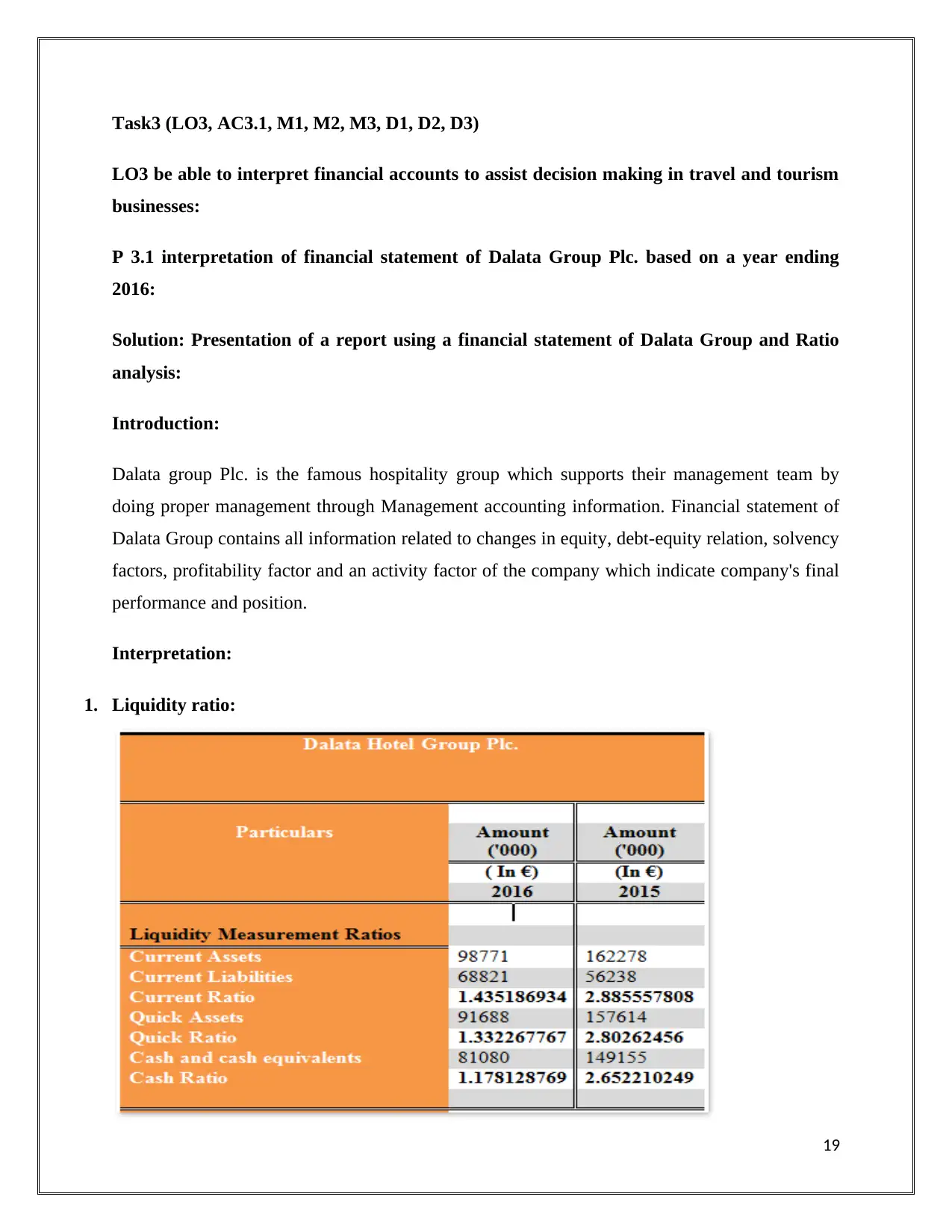
Task3 (LO3, AC3.1, M1, M2, M3, D1, D2, D3)
LO3 be able to interpret financial accounts to assist decision making in travel and tourism
businesses:
P 3.1 interpretation of financial statement of Dalata Group Plc. based on a year ending
2016:
Solution: Presentation of a report using a financial statement of Dalata Group and Ratio
analysis:
Introduction:
Dalata group Plc. is the famous hospitality group which supports their management team by
doing proper management through Management accounting information. Financial statement of
Dalata Group contains all information related to changes in equity, debt-equity relation, solvency
factors, profitability factor and an activity factor of the company which indicate company's final
performance and position.
Interpretation:
1. Liquidity ratio:
19
LO3 be able to interpret financial accounts to assist decision making in travel and tourism
businesses:
P 3.1 interpretation of financial statement of Dalata Group Plc. based on a year ending
2016:
Solution: Presentation of a report using a financial statement of Dalata Group and Ratio
analysis:
Introduction:
Dalata group Plc. is the famous hospitality group which supports their management team by
doing proper management through Management accounting information. Financial statement of
Dalata Group contains all information related to changes in equity, debt-equity relation, solvency
factors, profitability factor and an activity factor of the company which indicate company's final
performance and position.
Interpretation:
1. Liquidity ratio:
19
Paraphrase This Document
Need a fresh take? Get an instant paraphrase of this document with our AI Paraphraser
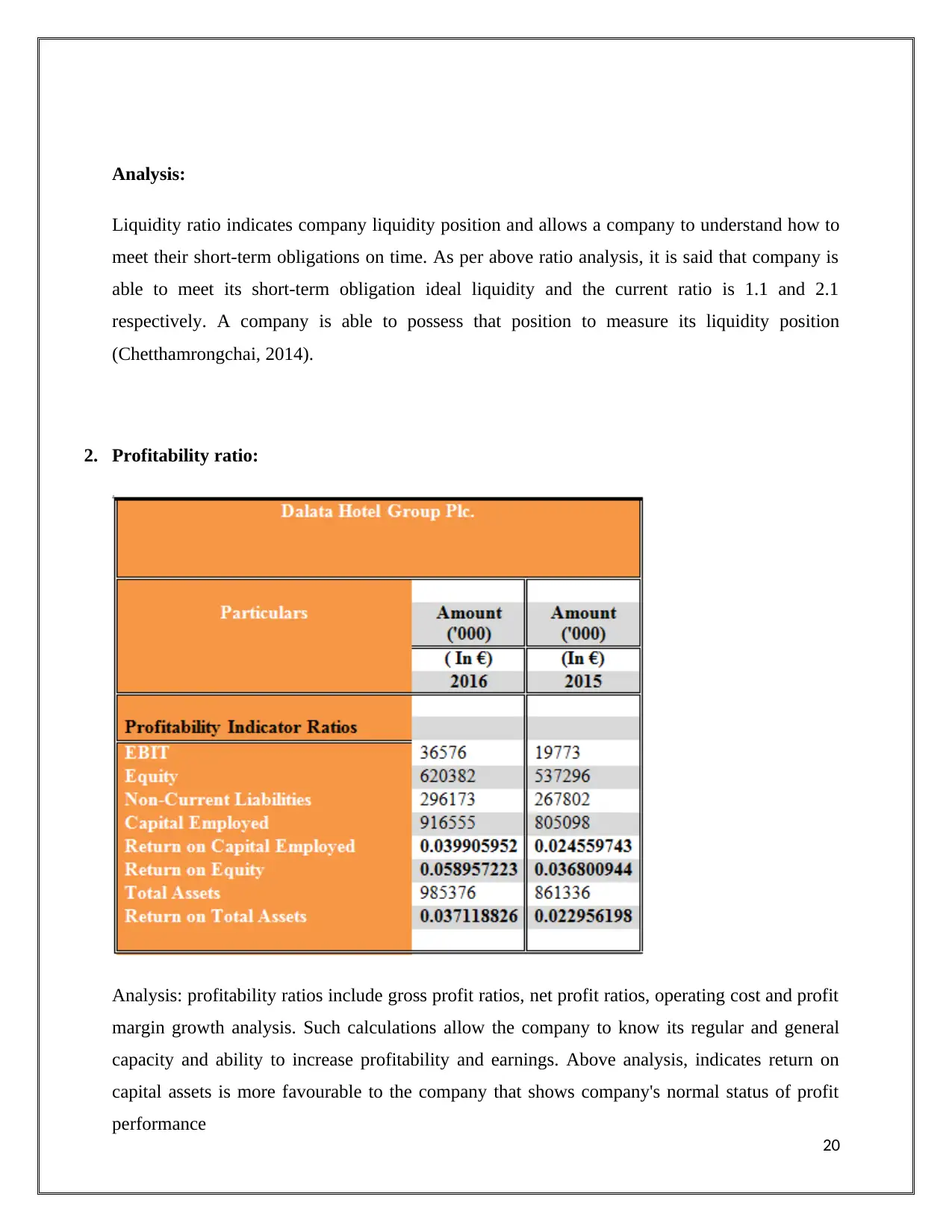
Analysis:
Liquidity ratio indicates company liquidity position and allows a company to understand how to
meet their short-term obligations on time. As per above ratio analysis, it is said that company is
able to meet its short-term obligation ideal liquidity and the current ratio is 1.1 and 2.1
respectively. A company is able to possess that position to measure its liquidity position
(Chetthamrongchai, 2014).
2. Profitability ratio:
Analysis: profitability ratios include gross profit ratios, net profit ratios, operating cost and profit
margin growth analysis. Such calculations allow the company to know its regular and general
capacity and ability to increase profitability and earnings. Above analysis, indicates return on
capital assets is more favourable to the company that shows company's normal status of profit
performance
20
Liquidity ratio indicates company liquidity position and allows a company to understand how to
meet their short-term obligations on time. As per above ratio analysis, it is said that company is
able to meet its short-term obligation ideal liquidity and the current ratio is 1.1 and 2.1
respectively. A company is able to possess that position to measure its liquidity position
(Chetthamrongchai, 2014).
2. Profitability ratio:
Analysis: profitability ratios include gross profit ratios, net profit ratios, operating cost and profit
margin growth analysis. Such calculations allow the company to know its regular and general
capacity and ability to increase profitability and earnings. Above analysis, indicates return on
capital assets is more favourable to the company that shows company's normal status of profit
performance
20

3. Debt ratio:
Analysis: this ratio represents solvency ability of the Dalata group:
Debt-equity ratio: debt ratio//total equity
Interest coverage ratio: debt of company/ total assets
These kinds of ratios are basically cover actual debt and equity relation of the company. That
shows
4. Operating performance ratio:
21
Analysis: this ratio represents solvency ability of the Dalata group:
Debt-equity ratio: debt ratio//total equity
Interest coverage ratio: debt of company/ total assets
These kinds of ratios are basically cover actual debt and equity relation of the company. That
shows
4. Operating performance ratio:
21
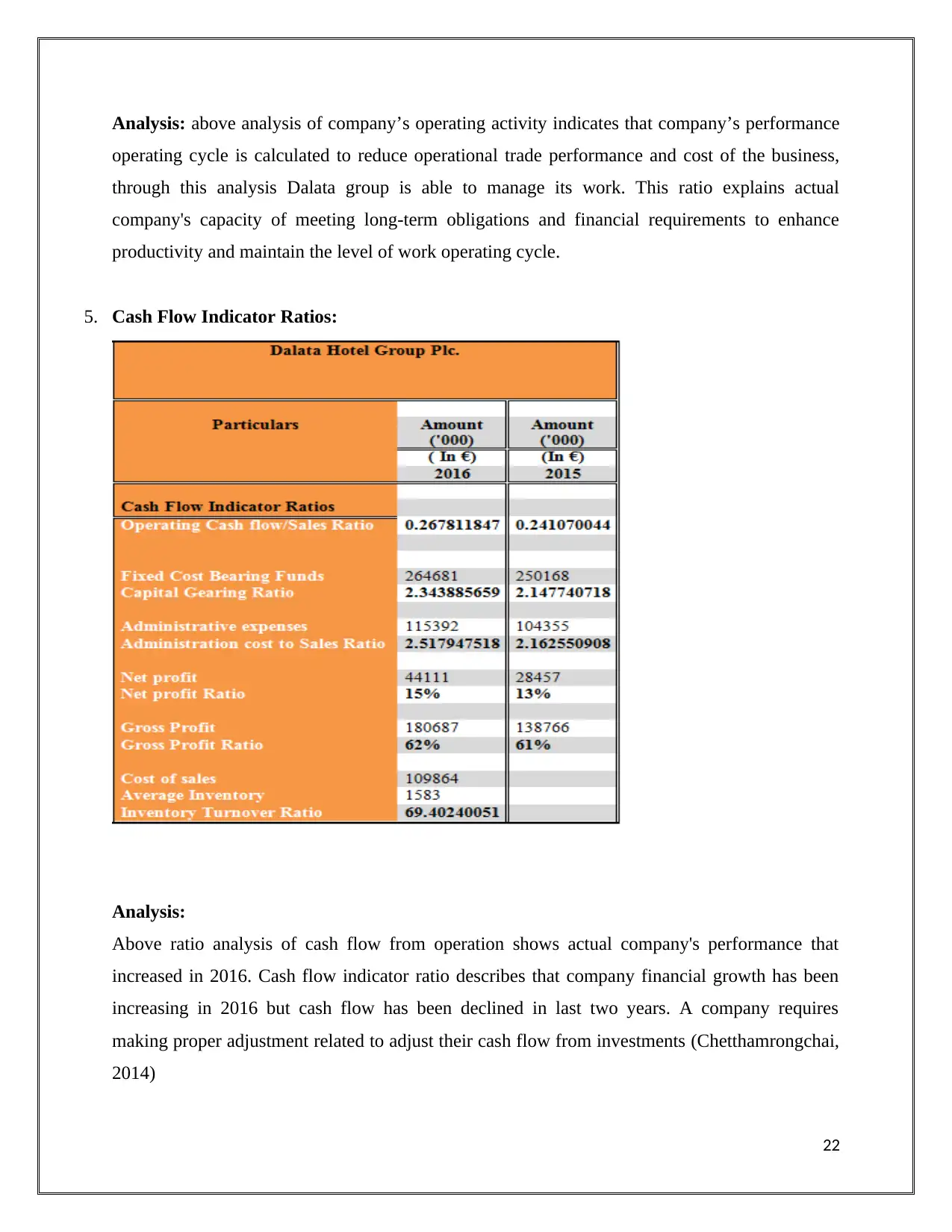
Analysis: above analysis of company’s operating activity indicates that company’s performance
operating cycle is calculated to reduce operational trade performance and cost of the business,
through this analysis Dalata group is able to manage its work. This ratio explains actual
company's capacity of meeting long-term obligations and financial requirements to enhance
productivity and maintain the level of work operating cycle.
5. Cash Flow Indicator Ratios:
Analysis:
Above ratio analysis of cash flow from operation shows actual company's performance that
increased in 2016. Cash flow indicator ratio describes that company financial growth has been
increasing in 2016 but cash flow has been declined in last two years. A company requires
making proper adjustment related to adjust their cash flow from investments (Chetthamrongchai,
2014)
22
operating cycle is calculated to reduce operational trade performance and cost of the business,
through this analysis Dalata group is able to manage its work. This ratio explains actual
company's capacity of meeting long-term obligations and financial requirements to enhance
productivity and maintain the level of work operating cycle.
5. Cash Flow Indicator Ratios:
Analysis:
Above ratio analysis of cash flow from operation shows actual company's performance that
increased in 2016. Cash flow indicator ratio describes that company financial growth has been
increasing in 2016 but cash flow has been declined in last two years. A company requires
making proper adjustment related to adjust their cash flow from investments (Chetthamrongchai,
2014)
22
Secure Best Marks with AI Grader
Need help grading? Try our AI Grader for instant feedback on your assignments.

Interpretation:
Above total analysis shows company actual financial position in the market. Through overall
ratio, it is concluded that company is able to avoid its future hurdles and threats to control
negative changes in the business. Changes in equity, gross margin are positive and profitable for
the company. Dalata group needs to control over uses of working capital and cash outflows in a
precise way to enhance productivity and proficiency level.
Conclusion:
Ratio analysis measure company actual position and financial status to analyse and make proper
adjustments related to cash flow statements, solvency, liquidity and profitability position. This
report concludes Dalata group performance through using financial analysis of company annual
reports including cash flow statements, changes in equity statements, balance sheets and P&L
account of the company.
23
Above total analysis shows company actual financial position in the market. Through overall
ratio, it is concluded that company is able to avoid its future hurdles and threats to control
negative changes in the business. Changes in equity, gross margin are positive and profitable for
the company. Dalata group needs to control over uses of working capital and cash outflows in a
precise way to enhance productivity and proficiency level.
Conclusion:
Ratio analysis measure company actual position and financial status to analyse and make proper
adjustments related to cash flow statements, solvency, liquidity and profitability position. This
report concludes Dalata group performance through using financial analysis of company annual
reports including cash flow statements, changes in equity statements, balance sheets and P&L
account of the company.
23

Task 4 (LO4, AC4.1, M1, M2, M3, D1, D2, D3)
LO4 – Understand sources and distribution of funding for public and non-public tourism
development
P 4.1 analyse sources and distribution of funding for the development of capital projects
associated with tourism.
Title: - Allocation of
funding for public & non-
public tourism
development
Private or non-public
sources and distribution of
funds for capital projects:
Angel funding: this is the
major funding alternative that
provides rights to the
substantial shareholders or
those shareholders who need
capital or additional funds to
set their business. These
shareholders a renown as angel
capital holders and angel
investors.
Seed capital:
Conclusion:
This leaflet provides reader
knowledge about various funding
resources for the development of
capital projects related to public
and non-public tourism sector.
This reading has also included
public and non-public tourism
alternative for raising funds.
These are major sources that
allow the company to invest in
capital projects to develop
tourism sustainable growth
(Blanke and Chiesa, 2013).
24
LO4 – Understand sources and distribution of funding for public and non-public tourism
development
P 4.1 analyse sources and distribution of funding for the development of capital projects
associated with tourism.
Title: - Allocation of
funding for public & non-
public tourism
development
Private or non-public
sources and distribution of
funds for capital projects:
Angel funding: this is the
major funding alternative that
provides rights to the
substantial shareholders or
those shareholders who need
capital or additional funds to
set their business. These
shareholders a renown as angel
capital holders and angel
investors.
Seed capital:
Conclusion:
This leaflet provides reader
knowledge about various funding
resources for the development of
capital projects related to public
and non-public tourism sector.
This reading has also included
public and non-public tourism
alternative for raising funds.
These are major sources that
allow the company to invest in
capital projects to develop
tourism sustainable growth
(Blanke and Chiesa, 2013).
24
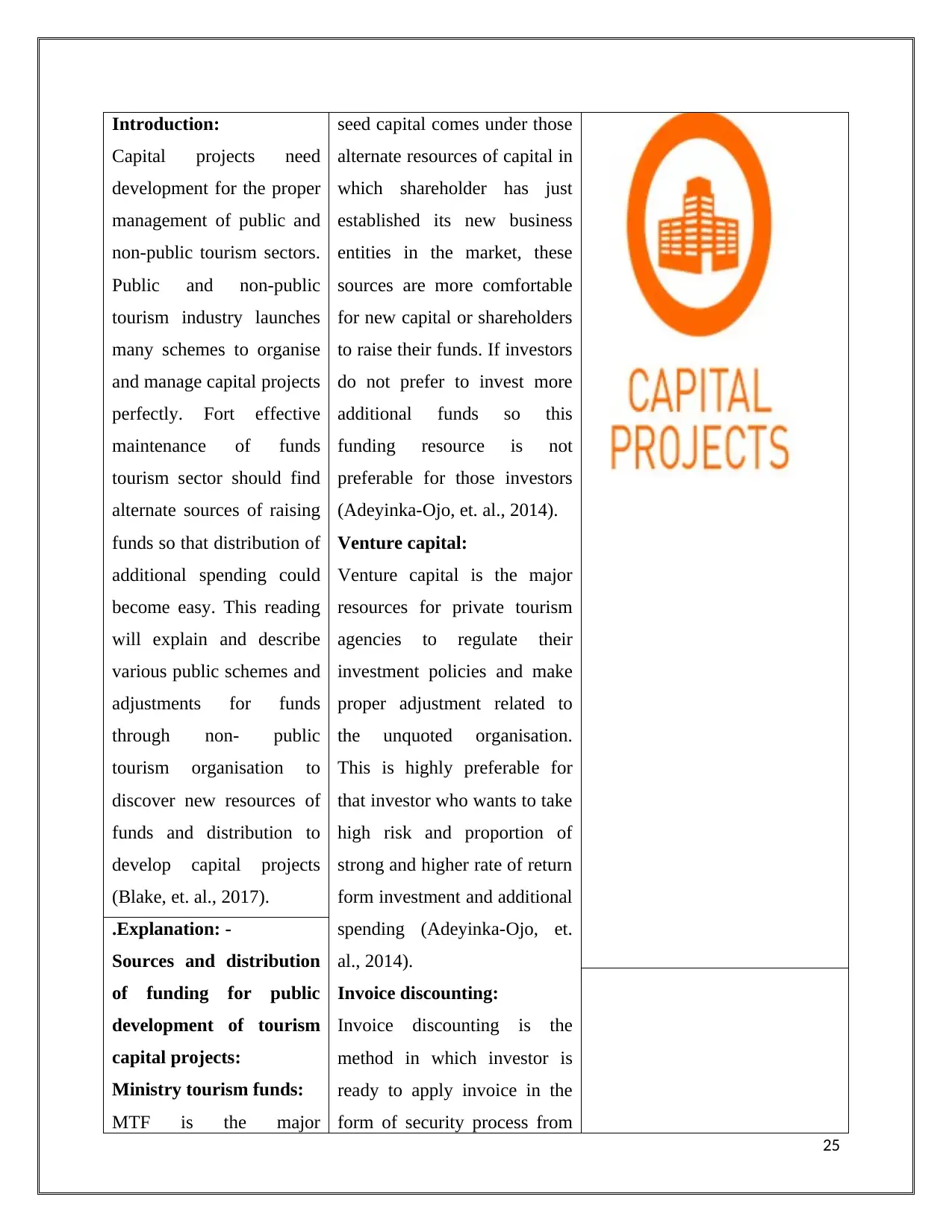
seed capital comes under those
alternate resources of capital in
which shareholder has just
established its new business
entities in the market, these
sources are more comfortable
for new capital or shareholders
to raise their funds. If investors
do not prefer to invest more
additional funds so this
funding resource is not
preferable for those investors
(Adeyinka-Ojo, et. al., 2014).
Venture capital:
Venture capital is the major
resources for private tourism
agencies to regulate their
investment policies and make
proper adjustment related to
the unquoted organisation.
This is highly preferable for
that investor who wants to take
high risk and proportion of
strong and higher rate of return
form investment and additional
spending (Adeyinka-Ojo, et.
al., 2014).
Invoice discounting:
Invoice discounting is the
method in which investor is
ready to apply invoice in the
form of security process from
Introduction:
Capital projects need
development for the proper
management of public and
non-public tourism sectors.
Public and non-public
tourism industry launches
many schemes to organise
and manage capital projects
perfectly. Fort effective
maintenance of funds
tourism sector should find
alternate sources of raising
funds so that distribution of
additional spending could
become easy. This reading
will explain and describe
various public schemes and
adjustments for funds
through non- public
tourism organisation to
discover new resources of
funds and distribution to
develop capital projects
(Blake, et. al., 2017).
.Explanation: -
Sources and distribution
of funding for public
development of tourism
capital projects:
Ministry tourism funds:
MTF is the major
25
alternate resources of capital in
which shareholder has just
established its new business
entities in the market, these
sources are more comfortable
for new capital or shareholders
to raise their funds. If investors
do not prefer to invest more
additional funds so this
funding resource is not
preferable for those investors
(Adeyinka-Ojo, et. al., 2014).
Venture capital:
Venture capital is the major
resources for private tourism
agencies to regulate their
investment policies and make
proper adjustment related to
the unquoted organisation.
This is highly preferable for
that investor who wants to take
high risk and proportion of
strong and higher rate of return
form investment and additional
spending (Adeyinka-Ojo, et.
al., 2014).
Invoice discounting:
Invoice discounting is the
method in which investor is
ready to apply invoice in the
form of security process from
Introduction:
Capital projects need
development for the proper
management of public and
non-public tourism sectors.
Public and non-public
tourism industry launches
many schemes to organise
and manage capital projects
perfectly. Fort effective
maintenance of funds
tourism sector should find
alternate sources of raising
funds so that distribution of
additional spending could
become easy. This reading
will explain and describe
various public schemes and
adjustments for funds
through non- public
tourism organisation to
discover new resources of
funds and distribution to
develop capital projects
(Blake, et. al., 2017).
.Explanation: -
Sources and distribution
of funding for public
development of tourism
capital projects:
Ministry tourism funds:
MTF is the major
25
Paraphrase This Document
Need a fresh take? Get an instant paraphrase of this document with our AI Paraphraser
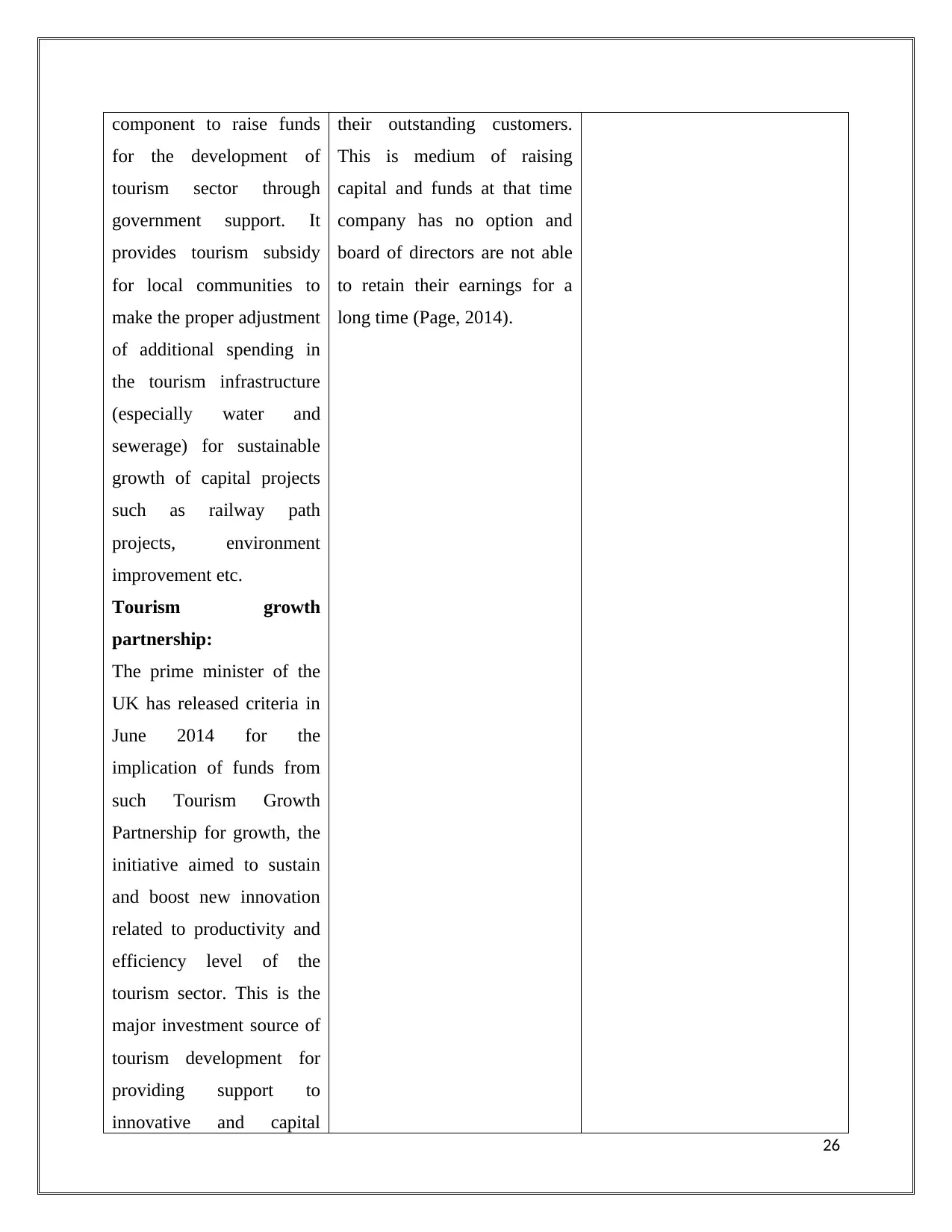
component to raise funds
for the development of
tourism sector through
government support. It
provides tourism subsidy
for local communities to
make the proper adjustment
of additional spending in
the tourism infrastructure
(especially water and
sewerage) for sustainable
growth of capital projects
such as railway path
projects, environment
improvement etc.
Tourism growth
partnership:
The prime minister of the
UK has released criteria in
June 2014 for the
implication of funds from
such Tourism Growth
Partnership for growth, the
initiative aimed to sustain
and boost new innovation
related to productivity and
efficiency level of the
tourism sector. This is the
major investment source of
tourism development for
providing support to
innovative and capital
their outstanding customers.
This is medium of raising
capital and funds at that time
company has no option and
board of directors are not able
to retain their earnings for a
long time (Page, 2014).
26
for the development of
tourism sector through
government support. It
provides tourism subsidy
for local communities to
make the proper adjustment
of additional spending in
the tourism infrastructure
(especially water and
sewerage) for sustainable
growth of capital projects
such as railway path
projects, environment
improvement etc.
Tourism growth
partnership:
The prime minister of the
UK has released criteria in
June 2014 for the
implication of funds from
such Tourism Growth
Partnership for growth, the
initiative aimed to sustain
and boost new innovation
related to productivity and
efficiency level of the
tourism sector. This is the
major investment source of
tourism development for
providing support to
innovative and capital
their outstanding customers.
This is medium of raising
capital and funds at that time
company has no option and
board of directors are not able
to retain their earnings for a
long time (Page, 2014).
26
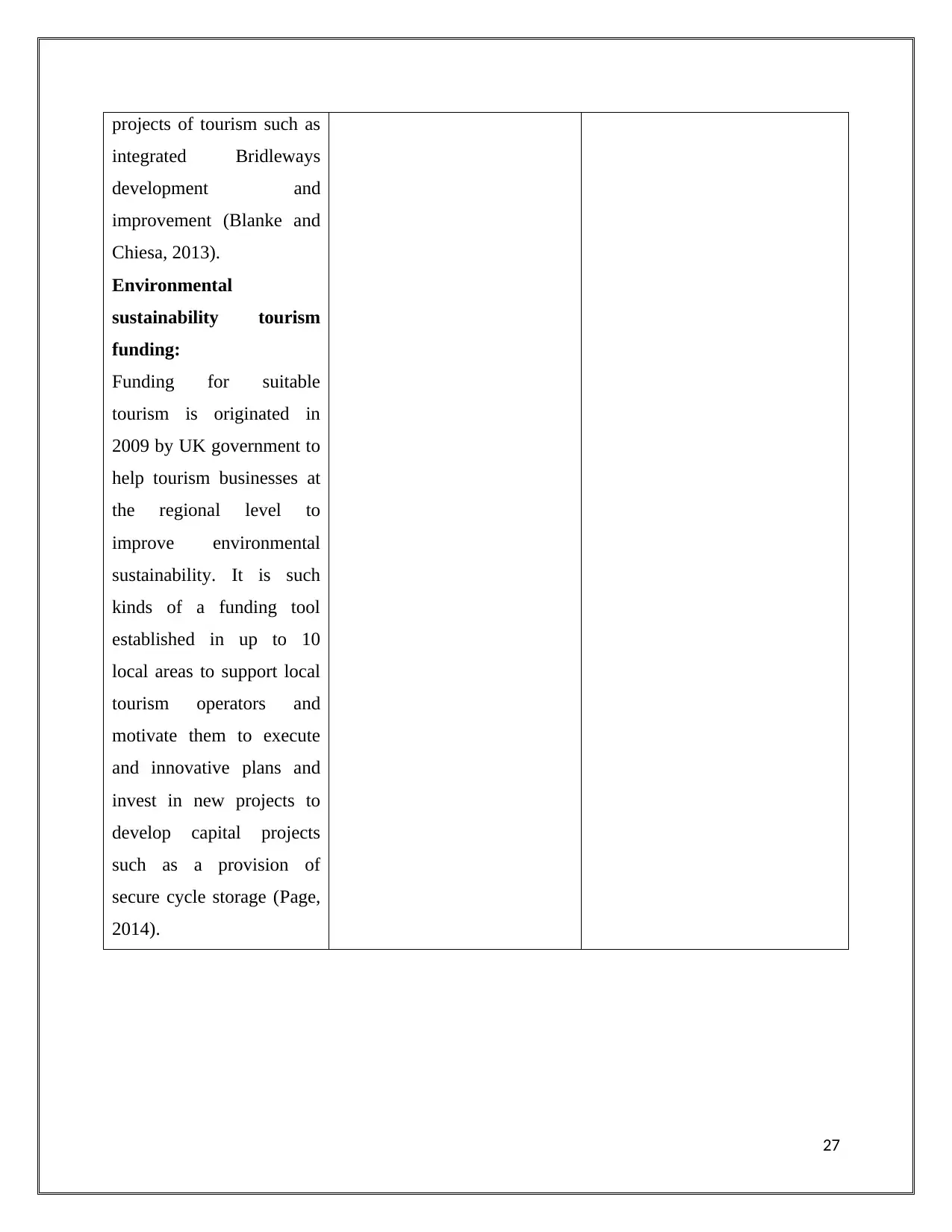
projects of tourism such as
integrated Bridleways
development and
improvement (Blanke and
Chiesa, 2013).
Environmental
sustainability tourism
funding:
Funding for suitable
tourism is originated in
2009 by UK government to
help tourism businesses at
the regional level to
improve environmental
sustainability. It is such
kinds of a funding tool
established in up to 10
local areas to support local
tourism operators and
motivate them to execute
and innovative plans and
invest in new projects to
develop capital projects
such as a provision of
secure cycle storage (Page,
2014).
27
integrated Bridleways
development and
improvement (Blanke and
Chiesa, 2013).
Environmental
sustainability tourism
funding:
Funding for suitable
tourism is originated in
2009 by UK government to
help tourism businesses at
the regional level to
improve environmental
sustainability. It is such
kinds of a funding tool
established in up to 10
local areas to support local
tourism operators and
motivate them to execute
and innovative plans and
invest in new projects to
develop capital projects
such as a provision of
secure cycle storage (Page,
2014).
27
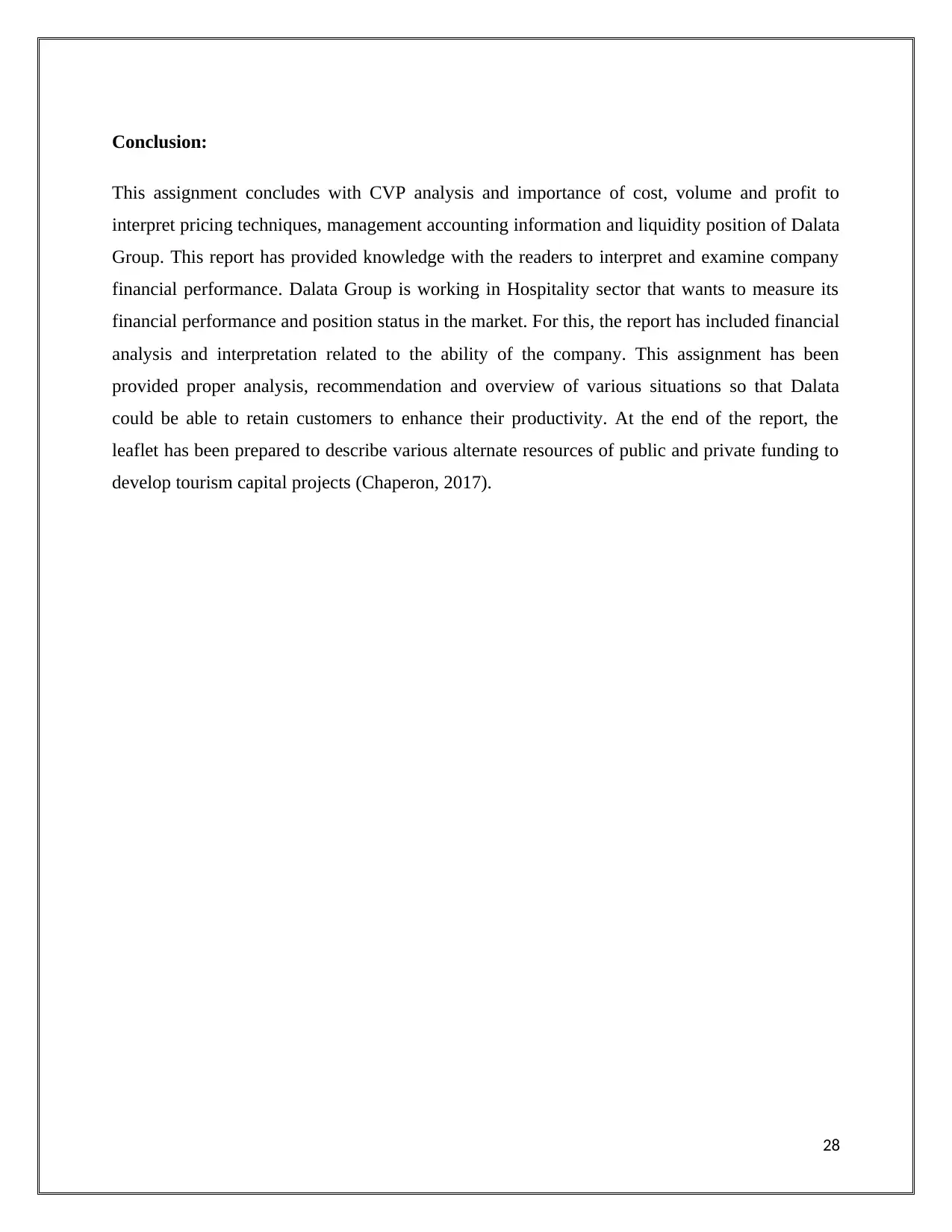
Conclusion:
This assignment concludes with CVP analysis and importance of cost, volume and profit to
interpret pricing techniques, management accounting information and liquidity position of Dalata
Group. This report has provided knowledge with the readers to interpret and examine company
financial performance. Dalata Group is working in Hospitality sector that wants to measure its
financial performance and position status in the market. For this, the report has included financial
analysis and interpretation related to the ability of the company. This assignment has been
provided proper analysis, recommendation and overview of various situations so that Dalata
could be able to retain customers to enhance their productivity. At the end of the report, the
leaflet has been prepared to describe various alternate resources of public and private funding to
develop tourism capital projects (Chaperon, 2017).
28
This assignment concludes with CVP analysis and importance of cost, volume and profit to
interpret pricing techniques, management accounting information and liquidity position of Dalata
Group. This report has provided knowledge with the readers to interpret and examine company
financial performance. Dalata Group is working in Hospitality sector that wants to measure its
financial performance and position status in the market. For this, the report has included financial
analysis and interpretation related to the ability of the company. This assignment has been
provided proper analysis, recommendation and overview of various situations so that Dalata
could be able to retain customers to enhance their productivity. At the end of the report, the
leaflet has been prepared to describe various alternate resources of public and private funding to
develop tourism capital projects (Chaperon, 2017).
28
Secure Best Marks with AI Grader
Need help grading? Try our AI Grader for instant feedback on your assignments.
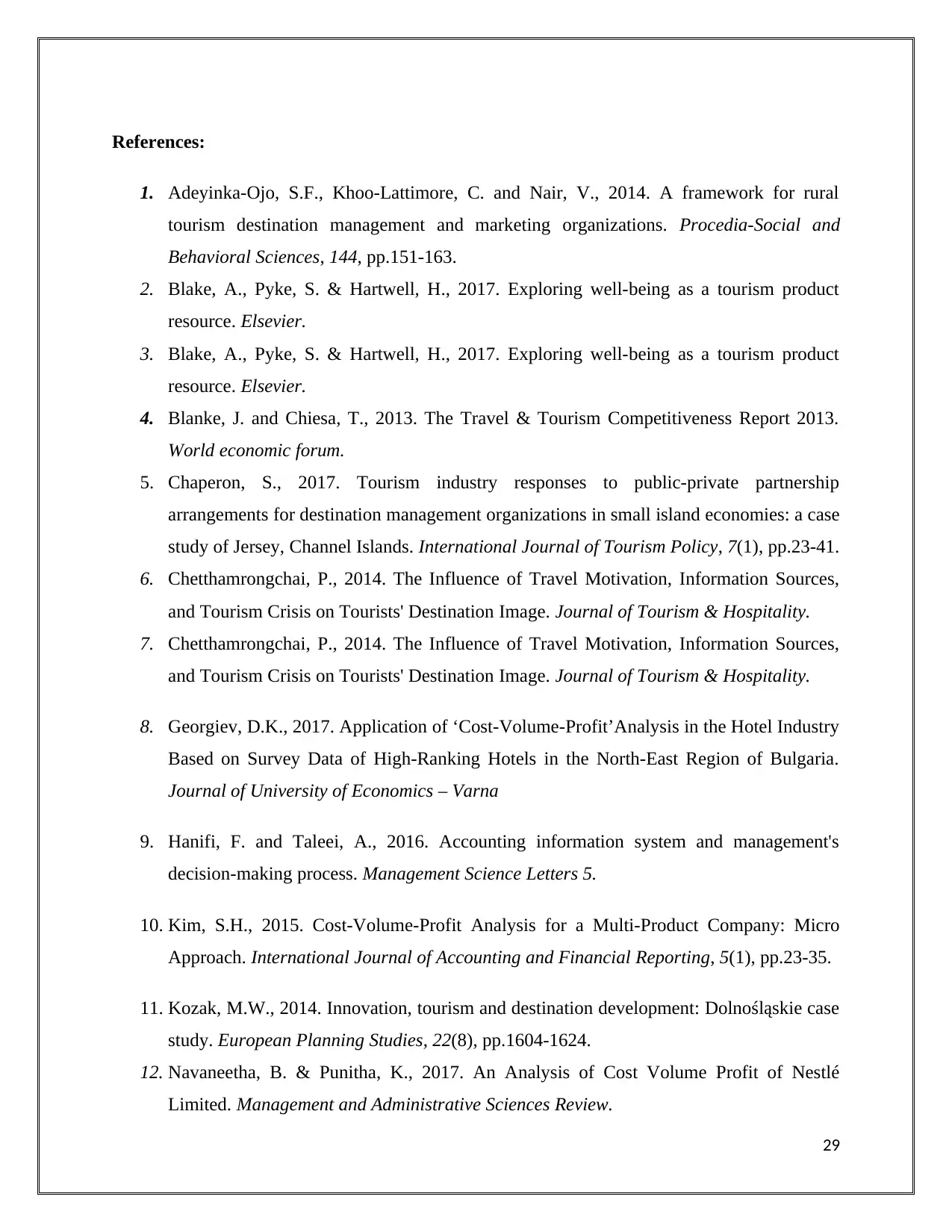
References:
1. Adeyinka-Ojo, S.F., Khoo-Lattimore, C. and Nair, V., 2014. A framework for rural
tourism destination management and marketing organizations. Procedia-Social and
Behavioral Sciences, 144, pp.151-163.
2. Blake, A., Pyke, S. & Hartwell, H., 2017. Exploring well-being as a tourism product
resource. Elsevier.
3. Blake, A., Pyke, S. & Hartwell, H., 2017. Exploring well-being as a tourism product
resource. Elsevier.
4. Blanke, J. and Chiesa, T., 2013. The Travel & Tourism Competitiveness Report 2013.
World economic forum.
5. Chaperon, S., 2017. Tourism industry responses to public-private partnership
arrangements for destination management organizations in small island economies: a case
study of Jersey, Channel Islands. International Journal of Tourism Policy, 7(1), pp.23-41.
6. Chetthamrongchai, P., 2014. The Influence of Travel Motivation, Information Sources,
and Tourism Crisis on Tourists' Destination Image. Journal of Tourism & Hospitality.
7. Chetthamrongchai, P., 2014. The Influence of Travel Motivation, Information Sources,
and Tourism Crisis on Tourists' Destination Image. Journal of Tourism & Hospitality.
8. Georgiev, D.K., 2017. Application of ‘Cost-Volume-Profit’Analysis in the Hotel Industry
Based on Survey Data of High-Ranking Hotels in the North-East Region of Bulgaria.
Journal of University of Economics – Varna
9. Hanifi, F. and Taleei, A., 2016. Accounting information system and management's
decision-making process. Management Science Letters 5.
10. Kim, S.H., 2015. Cost-Volume-Profit Analysis for a Multi-Product Company: Micro
Approach. International Journal of Accounting and Financial Reporting, 5(1), pp.23-35.
11. Kozak, M.W., 2014. Innovation, tourism and destination development: Dolnośląskie case
study. European Planning Studies, 22(8), pp.1604-1624.
12. Navaneetha, B. & Punitha, K., 2017. An Analysis of Cost Volume Profit of Nestlé
Limited. Management and Administrative Sciences Review.
29
1. Adeyinka-Ojo, S.F., Khoo-Lattimore, C. and Nair, V., 2014. A framework for rural
tourism destination management and marketing organizations. Procedia-Social and
Behavioral Sciences, 144, pp.151-163.
2. Blake, A., Pyke, S. & Hartwell, H., 2017. Exploring well-being as a tourism product
resource. Elsevier.
3. Blake, A., Pyke, S. & Hartwell, H., 2017. Exploring well-being as a tourism product
resource. Elsevier.
4. Blanke, J. and Chiesa, T., 2013. The Travel & Tourism Competitiveness Report 2013.
World economic forum.
5. Chaperon, S., 2017. Tourism industry responses to public-private partnership
arrangements for destination management organizations in small island economies: a case
study of Jersey, Channel Islands. International Journal of Tourism Policy, 7(1), pp.23-41.
6. Chetthamrongchai, P., 2014. The Influence of Travel Motivation, Information Sources,
and Tourism Crisis on Tourists' Destination Image. Journal of Tourism & Hospitality.
7. Chetthamrongchai, P., 2014. The Influence of Travel Motivation, Information Sources,
and Tourism Crisis on Tourists' Destination Image. Journal of Tourism & Hospitality.
8. Georgiev, D.K., 2017. Application of ‘Cost-Volume-Profit’Analysis in the Hotel Industry
Based on Survey Data of High-Ranking Hotels in the North-East Region of Bulgaria.
Journal of University of Economics – Varna
9. Hanifi, F. and Taleei, A., 2016. Accounting information system and management's
decision-making process. Management Science Letters 5.
10. Kim, S.H., 2015. Cost-Volume-Profit Analysis for a Multi-Product Company: Micro
Approach. International Journal of Accounting and Financial Reporting, 5(1), pp.23-35.
11. Kozak, M.W., 2014. Innovation, tourism and destination development: Dolnośląskie case
study. European Planning Studies, 22(8), pp.1604-1624.
12. Navaneetha, B. & Punitha, K., 2017. An Analysis of Cost Volume Profit of Nestlé
Limited. Management and Administrative Sciences Review.
29
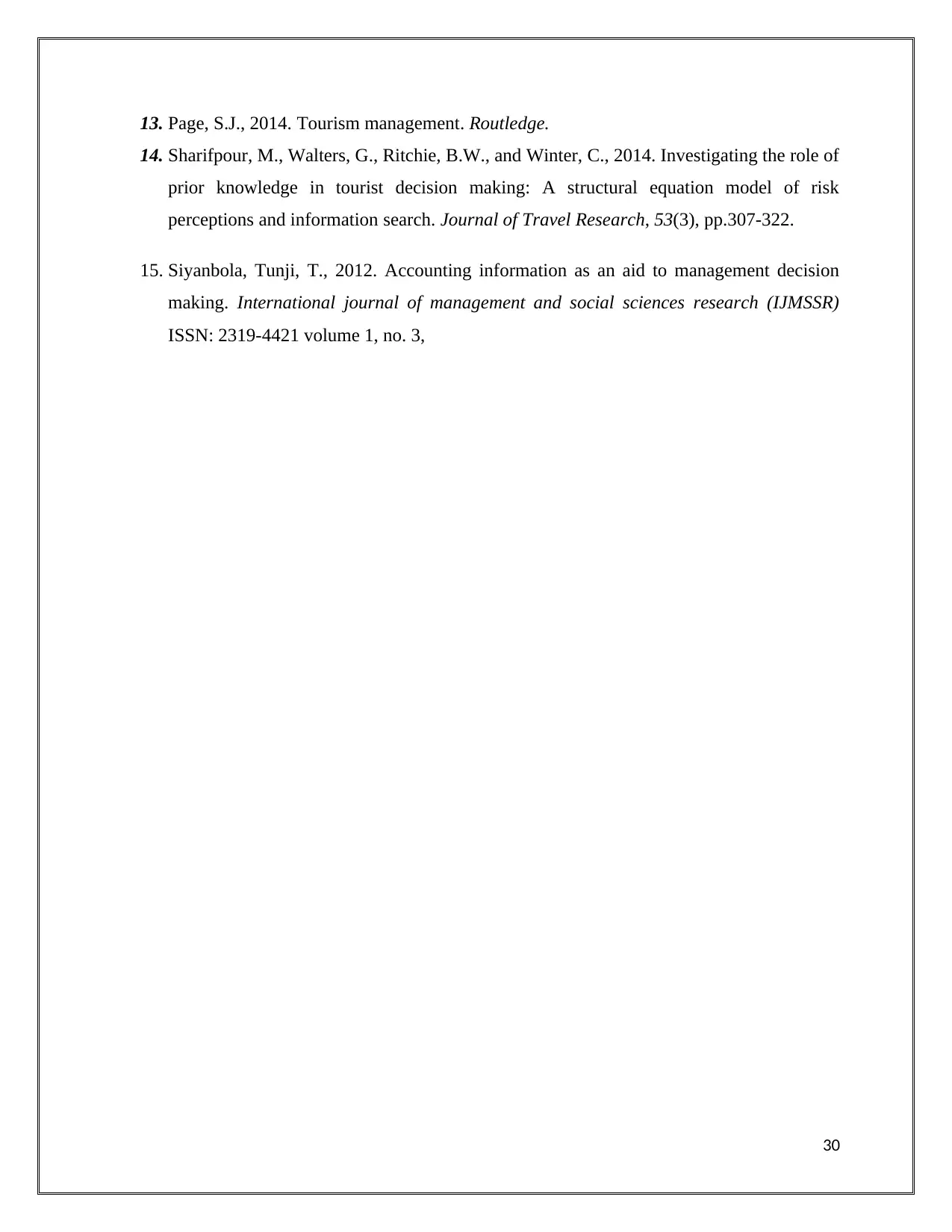
13. Page, S.J., 2014. Tourism management. Routledge.
14. Sharifpour, M., Walters, G., Ritchie, B.W., and Winter, C., 2014. Investigating the role of
prior knowledge in tourist decision making: A structural equation model of risk
perceptions and information search. Journal of Travel Research, 53(3), pp.307-322.
15. Siyanbola, Tunji, T., 2012. Accounting information as an aid to management decision
making. International journal of management and social sciences research (IJMSSR)
ISSN: 2319-4421 volume 1, no. 3,
30
14. Sharifpour, M., Walters, G., Ritchie, B.W., and Winter, C., 2014. Investigating the role of
prior knowledge in tourist decision making: A structural equation model of risk
perceptions and information search. Journal of Travel Research, 53(3), pp.307-322.
15. Siyanbola, Tunji, T., 2012. Accounting information as an aid to management decision
making. International journal of management and social sciences research (IJMSSR)
ISSN: 2319-4421 volume 1, no. 3,
30
1 out of 30
Related Documents
Your All-in-One AI-Powered Toolkit for Academic Success.
+13062052269
info@desklib.com
Available 24*7 on WhatsApp / Email
![[object Object]](/_next/static/media/star-bottom.7253800d.svg)
Unlock your academic potential
© 2024 | Zucol Services PVT LTD | All rights reserved.





